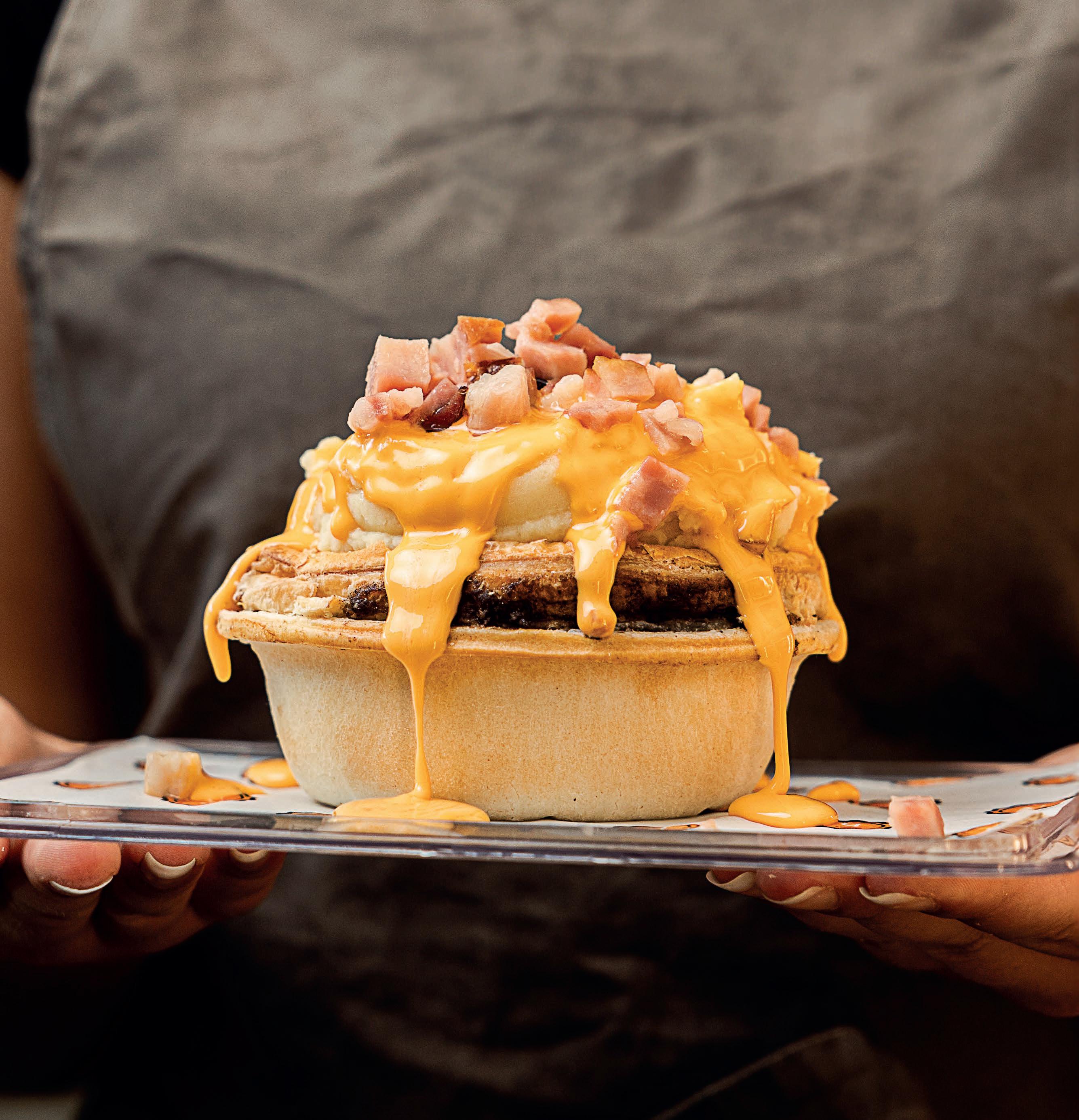






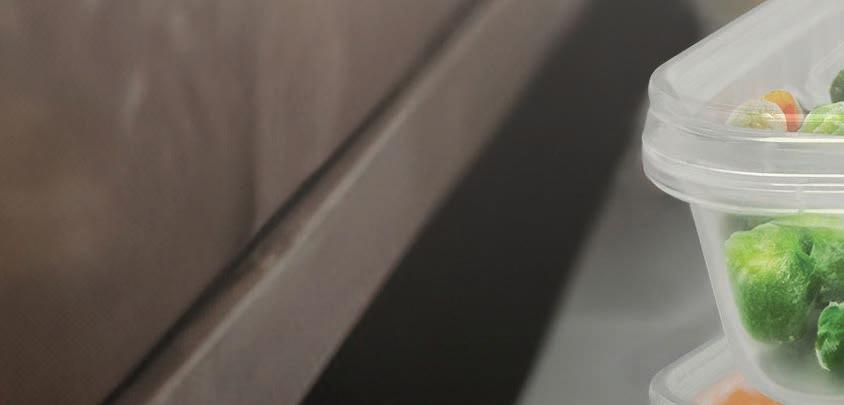






CODES:
Reusable Container
KMRGN750
Reusable Lid
KMRGNLID
An effective and innovative alternative to traditional single-use plastic, this simple and stackable solution is compliant with government regulations.
Developed specifically for commercial caterers, the Regen container meets the demands of professional kitchens. Its construction prioritises durability without compromising on material efficiency; robust enough to withstand daily use without succumbing to cracks or breaks. Crafted from clear plastic mono polymer (polypropylene), readily recycled at the end of its lifecycle. Approved by the Australian Packaging Covenant Organisation (APCO).
Reusable Food Container
Comes with optimised wall strength to ensure it doesn’t break or crack, maintaining the desired materials efficiency.
Commercial
Dishwasher Safe
Can sustain temperatures of 75°C and maintain its shape when exposed. Microwaveable and fridge/freezer safe.
Leak resistant due to the embedded seal in the lid.
Ensuring safe handling of hot food and avoiding food loss. simple and stackable solution for kitchens and catering.
Recyclable in Co-Mingled Recycling
Easily disposed of in co-mingled recycling. Can be collected, sorted and recycled in practice and at scale in Australia and New Zealand. Made with polypropylene so can be recycled when reaches its end of life.


SManaging Editor: Mike Wheeler
ustainability is a word that you are going to be hearing a lot more of over the next 18 months. It is a word that is doing the rounds in many industries, not just in the food and beverage sector. One dictionary definition is “avoidance of the depletion of natural resources in order to maintain an ecological balance”.
How is this going to affect our industry? Well, the greatest impact will probably be felt in the packaging sector.
As readers are aware, we have a regular contribution to the magazine from the Australian Institute of Packaging. You’ll note that column after column over the past two to three years has been dedicated to sustainable packaging, how to design better packaging, or has celebrated a range of awards won by those who are introducing such innovations to the industry.
The federal government enacted the National Waste Policy Action Plan (NWPAN) in 2019, whereby it set a target of all waste streams having a recycling return rate of 80 per cent by 2030. On current trajectory, a large number of these waste streams won’t make it for a variety of reasons – lack of infrastructure, education and sometimes political will.
However, that doesn’t mean this industry shouldn’t be doing its part. And in some cases, it is. Take Bunzl, for instance. The company saw a gap in the market when it comes to sustainability in the food space and released a range of containers aimed at consumers that can be used more than 700 times before they reach the end of their life.
It’s not only how the range is designed that is interesting, but how the company got there. Not satisfied with just making a product that might be reused every now and then, they went a few steps further.
First, it partnered with Genfac Plastics, which, as the name suggests, specialises in plastics manufacturing – but not just any plastics. Its goal is to produce products that not only leave a low carbon footprint but are also recyclable. The company manufactured Bunzl’s Katermaster Regen range with that in mind. As well as being able to be recycled via kerbside collection at the end of its life, the innovation won it a Gold at the 2025 Australasian Packaging Innovation and Design Awards (PIDA) in the Sustainable – Reuse and Refill category.
The likes of Bunzl are getting on the front foot with these kinds of innovations, not only because it is the right thing to do, but because it is becoming an expectation from the public at large. The younger generation especially is becoming more discerning in its choices around different ecological matters. Manufacturers are beginning to see that making a great product is now only part of the process – if the competition is making a great product and packaging it sustainably, then that is becoming a competitive advantage.
Companies like Bunzl and Genfac are on the front foot when it comes to meeting consumer demands in this space. Hopefully, in the near future, it will become the norm. F
Chairman: John Murphy
CEO: Christine Clancy
Managing Editor: Mike Wheeler
Ph: (02) 9439 7227
mike.wheeler@primecreative.com.au
Art Director: Michelle Weston
michelle.weston@primecreative.com.au
Sales/Advertising: Joanne Davies
Ph: 0434 785 611
joanne.davies@primecreative.com.au
Production Coordinator: Justine Nardone
Ph: (03) 9690 8766
justine.nardone@primecreative.com.au
Subscriptions AUS NZ O/S
1 year subscription 99 109119
2 year subscription 189 199 209 For subscriptions enquiries please email subscriptions@primecreative.com.au
Copyright Food & Beverage Industry News is owned by Prime Creative Media and published by John Murphy. All material in Food & Beverage Industry News is copyright and no part may be reproduced or copied in any form or by any means (graphic, electronic or mechanical including information and retrieval systems) without written permission of the publisher. The Editor welcomes contributions but reserves the right to accept or reject any material. While every effort has been made to ensure the accuracy of information, Prime Creative Media will not accept responsibility for errors or omissions or for any consequences arising from reliance on information published.
The opinions expressed in Food & Beverage Industry News are not necessarily the opinions of, or endorsed by the publisher unless otherwise stated.
© Copyright Prime Creative Media, 2023
Articles
All articles submitted for publication become the property of the publisher. The Editor reserves the right to adjust any article to conform with the magazine format.
Cover
Image: Atlas Copco
Head Office
379 Docklands Drive
Docklands VIC 3008
Ph: +61 3 9690 8766 enquiries@primecreative.com.au http://www.primecreative.com.au
Sydney Office
Suite 11.01, 11th Floor
201 Miller St North Sydney, NSW 2060, Australia

Printed by: Precision Group
83-89 Freight Drive, Somerton Vic. 3062
Ph: (03) 9490 1500


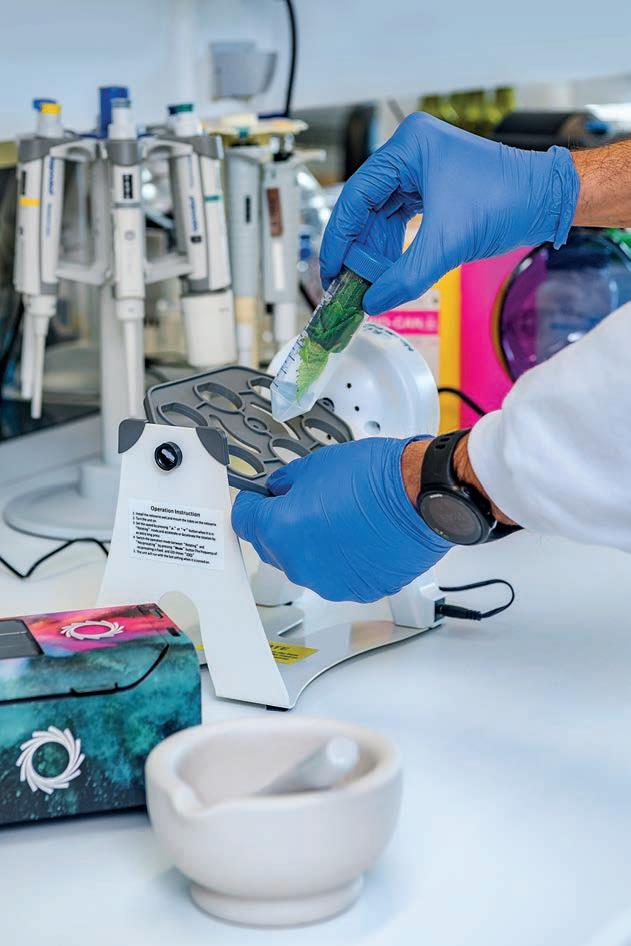
6 News
10 Meet the Manufacturer: Alchemy Cordial Obsessed with flavour, the founder of a cordial company turned values into reality.
14 Meet the Manufacturer: Barnes and Brown
Creating flavourful non-alcoholic spirits for non-drinkers.
18 Meet the Manufacturer: Beefy’s Pies
Starting as a local bakery, a national brand aims to elevate Aussie meat pies.
22 Bunzl
In packaging, end of life is just as important for sustainability.
24 APS Manufacturing Centre
APS’ facility is designed around the principles of digitalisation and customisation.
26 Fishbowl
With tailored services, Fishbowl provides smart inventory solutions with flexibility.
28 Endeavour Awards
For the first time, the 2025 Endeavour Awards will have a food innovation award.
29 Krones
From single machinery to complete turnkey lines, Krones offers flexible solutions.
30 WorldSkills
Being the third gold medal winner in his family, William Nickl shares his experience.
32 MICE
The coffee expo saw a rising discussion surrounding innovative packaging solutions.
34 Australian Wine Research Institute
The global grapevine nursery industry is reliant on clones for consistent quality.
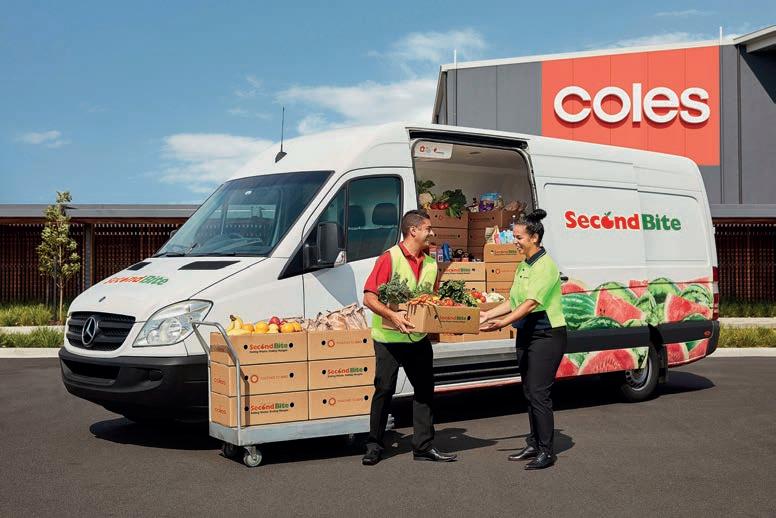
36 Food partnership
Mars Food Nutrition Australia and Foodbank partners to deliver truckloads of pasta sauces.
38 Instrumentation
To meet the standards of accurate measurement, VEGA provides solutions for the industry.
42 Food security
SecondBite gets creative with warehousing and logistics to feed hungry Australians.
44 AIP
Box-bottom paper bags stole the stage at the recent PIDA Awards.
46 Plant-based cheese
Researchers make fake cheese that stretch and melt like the real thing.
49 New Products







Beverage company Suntory has opened its $400 million facility in Swanbank, Queensland, alongside the official launch of its $3 billion multibeverage business, Suntory Oceania, to support growth in the beverage sector.
To grow the beverage sector across Australia and New Zealand, Suntory Oceania has created the region’s fourth-largest multi-beverage group, responsible for a portfolio of spirits, alcoholic beverages, juice, water, soft drinks, coffee and energy drinks.
Chief executive officer at Suntory Beverage & Food Oceania, Dai Minato, addressed the potential for growth in Australia.
“Our team has delivered incredible results in just over two years – the transformation of a greenfield site to a $400M state-of-the-art, carbonneutral facility and the establishment of a new supply chain and commercial model,” said Minato.
“We have grown our Oceania family to 1500 people, including new Licensed RTM and Advocacy teams.”
The new beverage facility in Queensland can produce 20 million cases per annum at start-up, with the capacity to expand to 50 million cases in the future.
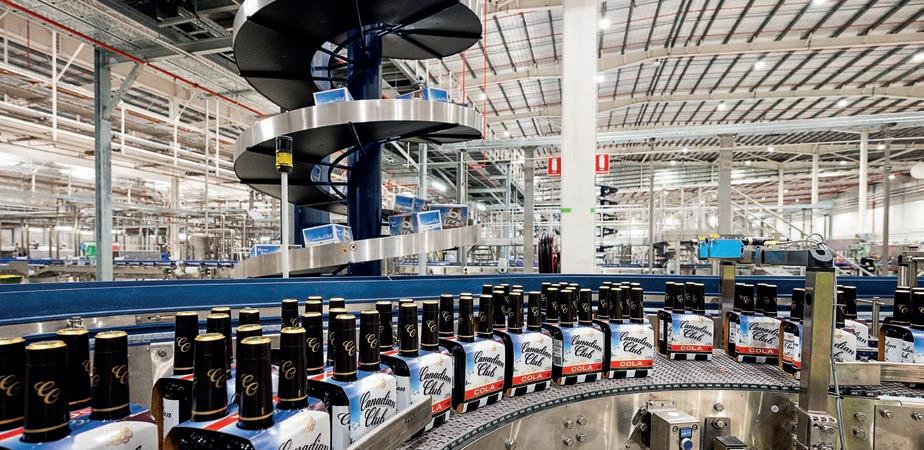

“The Australian beverages market is one of the most energetic and innovative in the world. Suntory Oceania gives us the platform to truly ignite the industry,” said managing director at Suntory Global Spirits –
Oceania, Mark Hill.
“Our Queensland facility complements our global production footprint – which includes distilleries and bottling sites across North America, Europe, and Japan – and
will produce more of the drinks Australians love, like those from the rapidly growing RTD category.”
The multi-beverage business in the New Zealand market will be launched in January 2026. F
Backed by the Australian government, Farm Foods Australia’s manufacturing plant in Breakwater has expanded its production capacity, creating new jobs and installing new equipment.
As part of a $45 billion investment by the government to create more local jobs and support community projects and infrastructure, the Geelong-based business upgraded
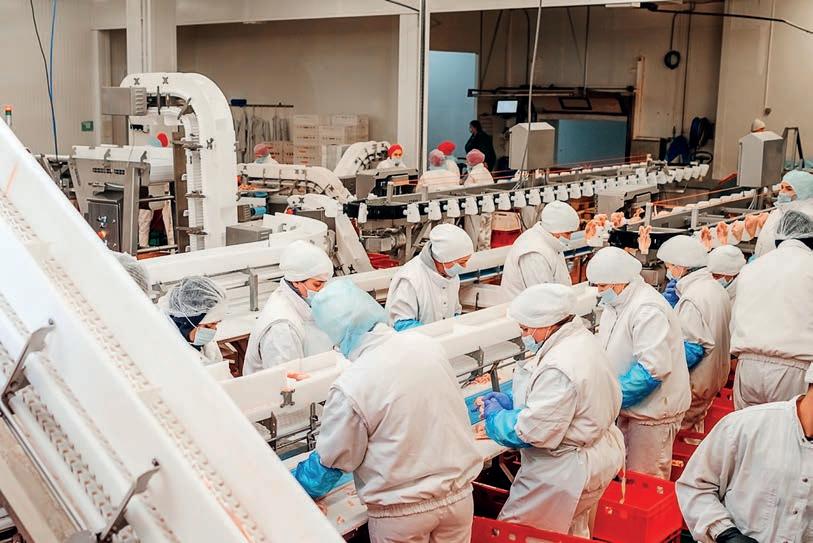
its food processing plant with advanced manufacturing technology and equipment, providing 24 new jobs for locals.
“We’re supporting regional Victorian businesses to take the next step, growing commercial confidence and helping make our regional towns and cities more resilient and better places to live, work and invest,” said minister for regional development Jaclyn Symes.
Farm Foods Australia specialises in pre-packaged meat products. The upgraded machinery enables an increase in production from 20 to 30 trays per minute, helping the business boost sales.
Starting small in Birregurra as a shop selling handmade meat products, wine, cheese and condiments, the business moved into food manufacturing in 2013.
Farm Foods Australia is now a
supplier to major retailers across Australia.
“Continuing the integration of cutting-edge technology is critical and has not only facilitated higher production output but has also contributed to improvements in both consistency and quality,” said managing director at Farm Foods Australia Greg Hughes.
“The investment has also led to the creation of new product formats and sales into new market channels.”
With government support, the expansion will help meet growing demand for Australian meat products while securing jobs for the local community.
“We’re excited to support Farm Foods Australia as the business continues to grow and invest in regional Victoria, and create more jobs in our community,” said state member for Geelong Christine Couzens. F
The Australian Competition and Consumer Commission (ACCC) has not opposed Lactalis’ proposed acquisition of Fonterra’s consumer and food service businesses.
Given Lactalis’ reputation and the demand for high-quality dairy products in Australia, the ACCC cited minimal concerns about competition.
Lactalis and Fonterra both source raw milk directly from dairy farmers in Victoria and Tasmania, where they process and supply various dairy products across Australia.
Additionally, Lactalis and Fonterra have different product focuses, which reduces concerns about competition or overlap in the acquisition.
“While we acknowledge the concerns raised by some representative bodies, after careful consideration we have determined that the acquisition is unlikely to result in a substantial lessening of competition,” ACCC deputy chair Mick Keogh said.
The ACCC found that in the regions of Gippsland, the Murray and Western Victoria, the presence of alternative buyers of raw milk would continue to limit Lactalis’ market power if the acquisition proceeds.
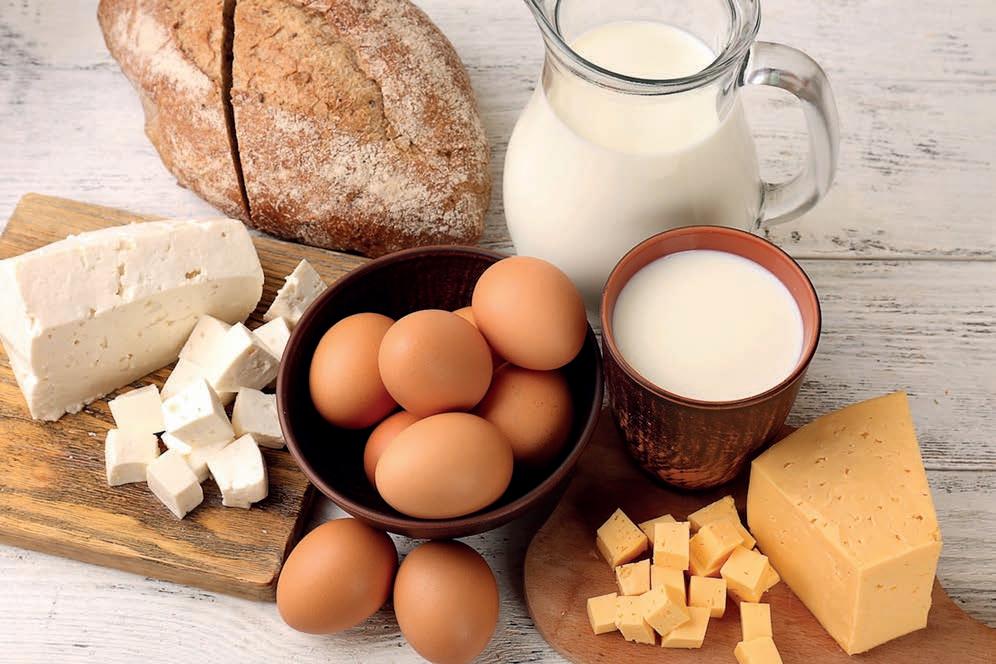
The ACCC concluded that the transaction was unlikely to substantially lessen competition in the wholesale supply of dairy
products such as drinking milk, cream, cheese, chilled yellow spreads, and dairy ingredients like milk powder. It stated that the differing
production focus of Fonterra and Lactalis meant there was limited overlap between the two in the supply of these products. F
Alexia Horley has been appointed as the new chief executive officer for PepsiCo Australia and New Zealand Foods.
Currently serving as general manager of Australia Foods for PepsiCo, her new role as CEO commenced on 21 July 2025.
“Alexia’s strong strategic mindset, relentless consumer focus and deep expertise in the ANZ retail landscape position her perfectly to lead the business forward,” said CEO APAC Foods Anne Tse.
“She’s a highly respected and dynamic leader and I’m looking forward to partnering with her as we continue to build momentum and shape the future of ANZ Foods.”
As GM of Australia Foods, Horley played a critical role in transforming the business through product innovation across new formats,
guided by her focus on consumers.
Under her leadership, PepsiCo Australia’s manufacturing footprint has expanded, including investment in multipack capabilities and an additional production line for Red Rock Deli to support continued growth.
“I’m honoured to step into the role of CEO and excited to lead such a passionate and talented team,” said Horley.
“I’m committed to building on our strong foundations and driving sustainable growth across every part of the ANZ Foods business, and most importantly, continuing to deliver the best snacks to Aussie and Kiwi consumers under our iconic portfolio of brands.”
Current CEO Kyle Faulconer has been appointed SVP, PepsiCo North America Commercial. F
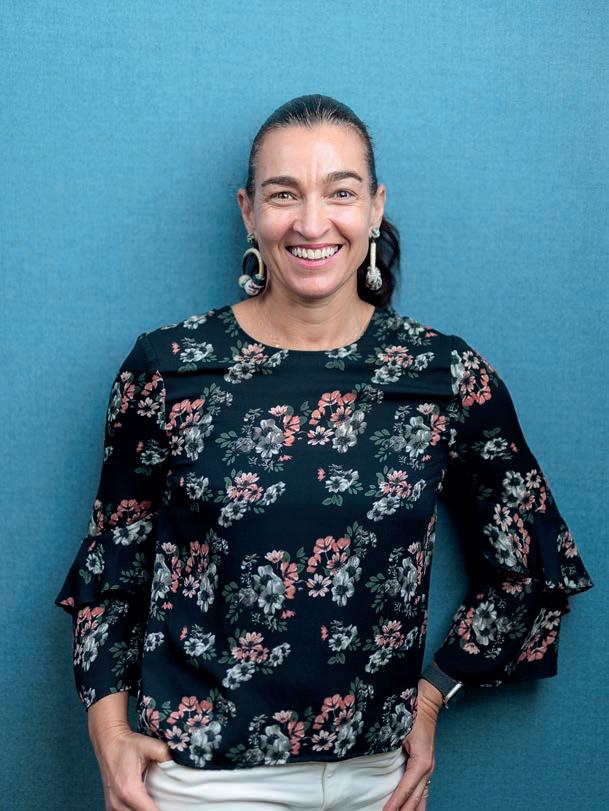
The Central Highland Iona Project has been officially declared a prescribed project by the Queensland government. The facility is designed to process up to 200,000 head of cattle each year, strengthening Queensland’s beef industry and supporting regional economic growth.
Located in Emerald, the Iona Project will include a state-of-the-art beef processing facility incorporating advanced technologies such as robotics, automation and artificial intelligence.
The development is expected to create 188 jobs during the construction phase and a further 427 ongoing operational roles.
“Queensland is Australia’s greatest cattle producer and the LNP is backing our graziers and beef industry by partnering with the private sector to further grow the industry,” said deputy premier and minister for state
development, infrastructure and planning Jarrod Bleijie.
“The Iona Project has the potential to enhance Queensland’s beef processing capabilities while creating economic development opportunities across regional Queensland.”
Minister for primary industries Tony Perrett reinforced the government’s commitment to growing the sector, reiterating its target to increase the value of primary industries to $30 billion by 2030.
Assistant minister for primary industry development and member for Gregory Sean Dillon also welcomed the declaration, emphasising its significance for the agricultural industry and local economies.
“This project represents a significant opportunity to boost productivity and profitability across our beef supply chain while ensuring
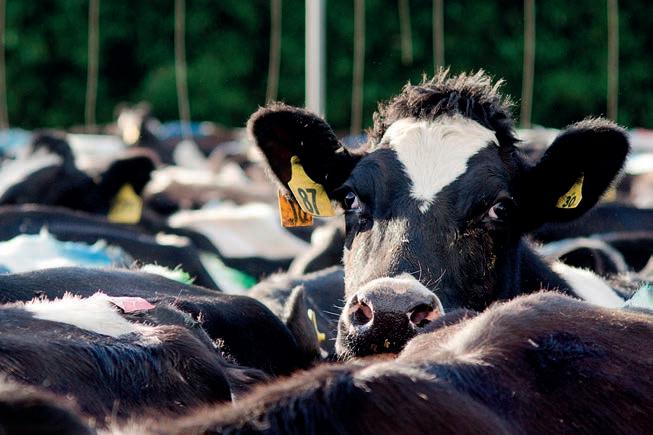
Queensland’s producers remain globally competitive,” said Dillon.
“By taking advantage of innovative technologies, the Iona Project could
A new $10 million funding package has been announced by the Victorian government to help food, dairy and beverage manufacturers switch to electric alternatives.
This funding is part of a $15 million program aimed at reducing gas pollution on farms and in food manufacturing facilities. Based on a successful project in Aotearoa New Zealand with the Fonterra dairy
co-operative, the initiative enables food and beverage manufacturers to replace gas boilers and heating systems with electric alternatives.
The program aims to demonstrate that electrification can reduce emissions while saving manufacturers thousands in gas costs. Implementing clean energy practices in gasreliant sectors is expected to propel the broader food and beverage
manufacturing sector towards improved efficiency.
“The Greens are proud to have negotiated this innovative $15 million climate project to help farms and food manufacturers get off gas and go all-electric, saving huge amounts of emissions and saving thousands off farmers’ energy bills,” said leader of the Victorian Greens Ellen Sandell.
Drawing on New Zealand’s Rewiring
help future-proof Queensland’s beef industry and open the door to new markets and greater export opportunities.” F
Aotearoa initiative, the remaining $5 million will support farmers to transition to electric heat pumps, solar panels and battery storage.
The funding is part of a broader $40 million climate and electrification package secured in the recent state budget and tax bills. It is expected to assist five to ten food manufacturing sites and 20 farms in transitioning to electric alternatives. F
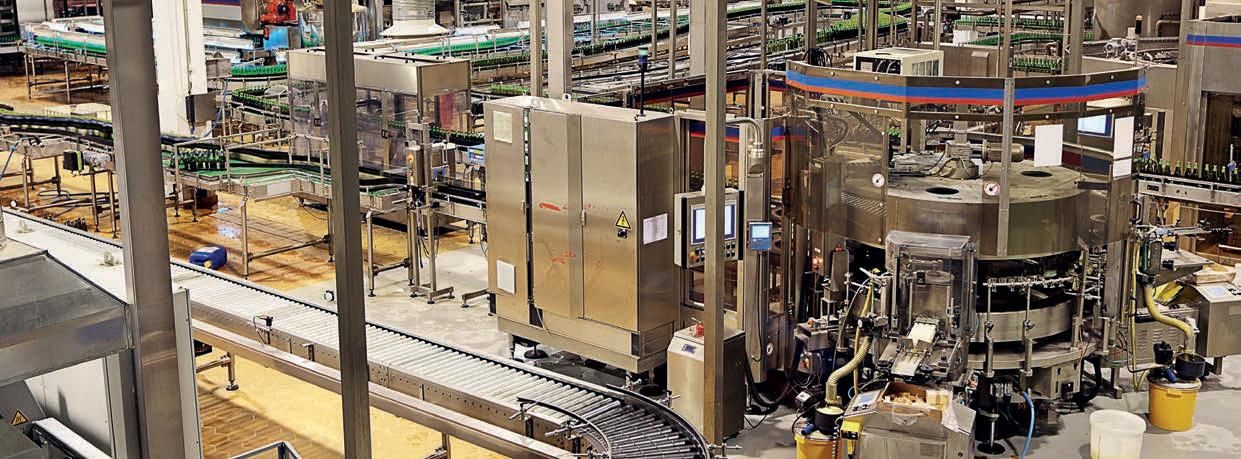
Popular family-owned chocolate maker Haigh’s Chocolates has announced the retirement of chief executive officer Alister Haigh, who has led the company for 30 years.
Current chief operating officer Peter Millard will step into the role, marking the first time someone outside the Haigh family has been appointed as CEO in the business’s 110-year history.
The transition comes at a significant time for the company, with the upcoming completion of a $130 million manufacturing facility in Salisbury South and the opening of its seventh store in Broadway, Sydney.
Alister Haigh, who plans to continue championing the legacy of Haigh’s, welcomed Millard into the leadership of the family-owned business.
“Peter has been integral to our success here at Haigh’s, responsible for the businesses day-to-day operations while proudly spearheading the development of our Salisbury South facility alongside a high-performing team,” said Haigh.
“His work ethos is a testament to the Haigh’s values of contribution, determination and trust.
“I feel confident knowing that the business will continue to thrive and grow under his exceptional leadership.”
Millard has been involved with the company for 19 years. His past four years as COO were preceded by a long tenure as supply chain manager.
He expressed his passion and gratitude.
“Having had the privilege to work closely with Alister for nearly two decades, I have been inspired by his ambitious, humble and personable leadership,” he said.
“Alongside the family I remain passionate about preserving the enduring quality of Haigh’s premium chocolate to delight generations of chocolate lovers for years to come.”
According to board chair Carolyn Mitchell, Millard underwent an extensive interview process that included an external panel to assess his suitability for the role. She stated
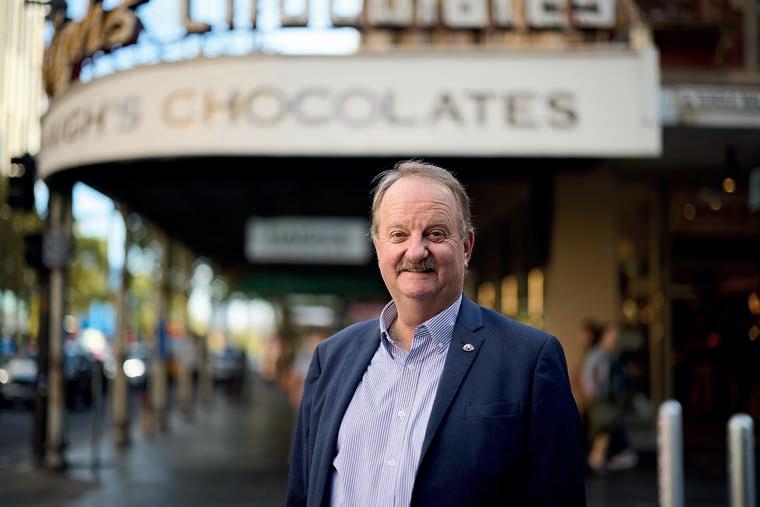
that his passion, determination, and aligned vision were decisive in his appointment.
Over the past 30 years, Alister Haigh has expanded the company’s operations, which now produce more than 1,000 tonnes of chocolate each year. He will remain on the board alongside fourthgeneration family members Simon Haigh and Sara Fitzgerald.
As part of a $10 million investment into new manufacturing hubs announced in the 2025–26 Budget, the Queensland government is backing the Sunshine Coast’s establishment of a new manufacturing hub.
The Sunshine Coast Manufacturing Hub will provide targeted support to boost the region’s manufacturing sector. It aims to help local manufacturers modernise while creating jobs.
According to minister for manufacturing Dale Last, the broader Sunshine Coast region is home to more than 4,000 manufacturing businesses. Employing more than 33,000 workers, he said the hub will drive industrial growth in the state.
“The Crisafulli government is focused on growing Queensland’s manufacturing capabilities and giving regions like the Sunshine Coast a fresh start by backing the industries that will shape our future,” said Last.
“This is a smart, future-focused investment in a region that already has a strong track record in innovation.”
“Reflecting on my time, it’s incredible to think how far we have come over the years with more than 300 chocolate varieties, 900 employees, 21 stores and grown tenfold all while remaining true to the heritage and quality Haigh’s is known for,” he said.
The transition will become official from 4 August 2025. F

Member for Caloundra Kendall Morton mentioned that food and beverage production was one of the key industries the hub will support to drive the Sunshine Coast’s economic future.
“The Sunshine Coast is one of the largest manufacturing regions in Queensland, and it’s important we invest in the industries that create secure, skilled jobs close to home,” said Morton.
“This new manufacturing hub will focus on supporting the unique strengths and needs of the Sunshine
Coast, including its growing capabilities in food and beverage, health and medical products, aviation and aerospace, and building materials.
“Our region already leads the way, and this hub will give local businesses the support they need to innovate and grow.” F
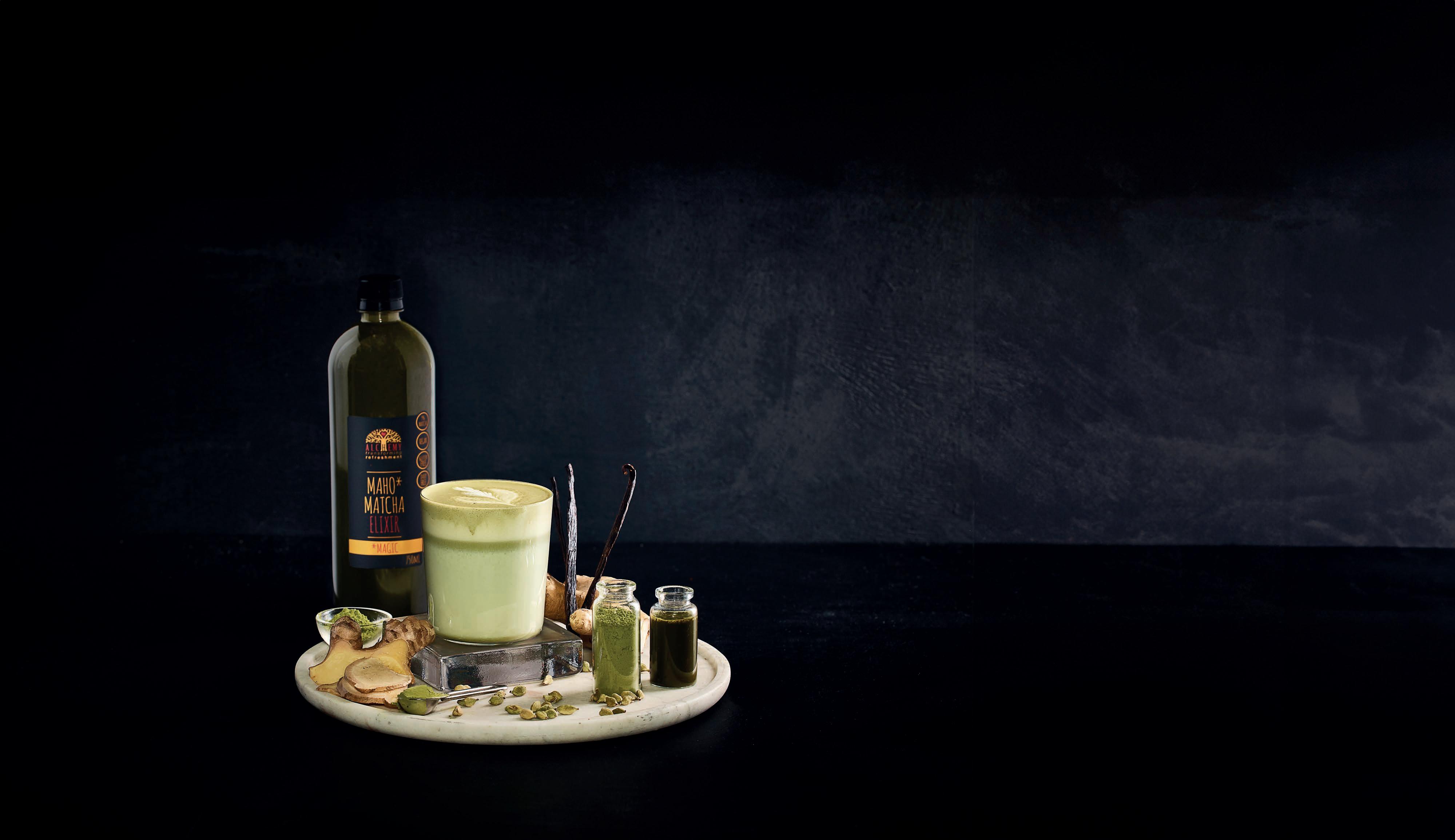
From beverage business to café supplier, a founder of a beverage manufacturing company focuses on quality and flavour in every aspect of the business. This is his story.
It all started with chilli cordial.
Founder of Alchemy Cordial Company, Michael Bishop, had no idea that a bold leap taken 30 years ago tasting his friend’s lemon and chilli cordial would change the course of his life.
Bishop recalled his initial reluctance when his friend persistently offered the family recipe, which he referred to as a “combination of fire and water”. After finally giving in and trying the unique drink, his mind was blown, sparked with fireworks of ideas, spiralling into experimentation, including mixing it with vodka.
Taken over by the flavour until 3 o’clock in the morning, Bishop and his friend knew what they needed to do.
“We decided we were going to make the world’s first chilli soft drink,”
he said. “That was our destiny.”
Although their passion and dedication soared above all doubts, they soon met the realities of the beverage business.
“The soft drink business is massive and led by multinationals,” he said. “It’s intensely competitive because you’re fighting for just that little bit of shelf space on the supermarket shelf.”
Eighteen months later, Bishop’s friend, who was also his business partner, returned to his old job after the business struggled with financial realities. However, Bishop could not let go of the flavour. While he adored the taste, he understood the limitations of becoming a soft drink baron and made a key realisation about the wider demographic who might enjoy that flavour.
“That chilli and lemon cordial tasted amazing, but it only appealed to blokes who like ginger beer,” said Bishop. “There was nothing there for those that wanted a more ethereal or beautiful experience.”
After researching the market, Bishop repositioned the brand as a cordial and syrup supplier, evolving into a company that enables efficient beveragemaking in cafés and homes alike.
Alchemy
Cordial’s obsession with flavour reflects a commitment to delivering consistency through creativity and joy for the palate. While skilled café baristas prioritise taste, Bishop noted they often lack the processes or resources to reproduce the same drink every time.
Rather than requiring baristas to add multiple ingredients into each drink, Alchemy Cordial offers syrups that combine these components, condensing them into a single bottle for direct and convenient use.
Bishop explained that the company uses only plant-based products. All products are free from gluten, dairy and allergens, and contain no artificial colours or flavours. He also highlighted the benefits of using concentrated products.
“Alchemy Cordial’s syrups and concentrates are shelf stable and can sit on a bench in a café for 18 months to two years,” he said.
For cafés and baristas seeking flavour consistency these long-life products offer a distinct advantage. According to Bishop, a 750ml bottle of concentrated syrup can make
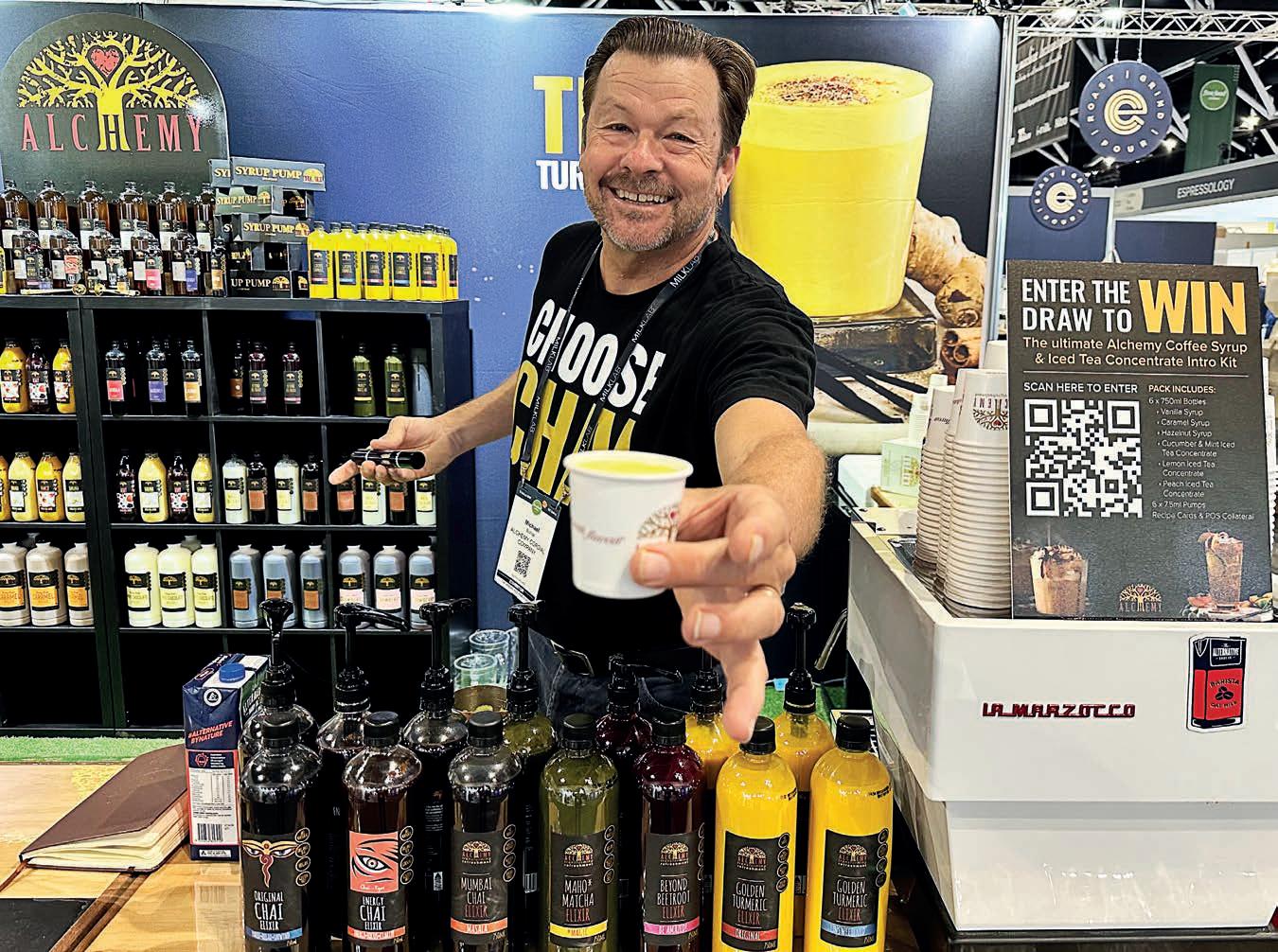

up to 50 drinks. This, he explained, is part of a broader commitment to the food service industry, and in particular cafés, by providing a solution to satisfy increasingly complex beverage orders in a way that is easy to execute, full of flavour and profitable.
Over the years, the company has grown, leading to expansions and larger facilities. For the past 15 years, all manufacturing and processing has taken place at its fifth and latest facility in Cleveland, Queensland.
Discussing the plant-based products and facility, Bishop explained how the company’s longterm vision for sustainability has shaped its operations since the early days. Long before sustainability became a mainstream business focus, Alchemy Cordial was already
“Alchemy Cordial’s syrups and concentrates are shelf stable and can sit on a bench in a café for 18 months to two years.”
working to reduce its environmental impact by using plant-based alternatives instead of animal-based or synthetic ingredients.
However, as sustainability gained traction across industries, Bishop had to make the company’s practices more visible to customers and clients.
Bishop said Alchemy Cordial operates under the British Retail Consortium (BRC) food safety system, which is a recognised Global Food Safety Initiative (GFSI) standard, with the facility certified as plant-based and gluten-free. These certifications support safer
there’s no dairy, there’s no gluten. People who buy our products can do so without risk or fear as there’s nothing that is going to cause a problem.”
The business is also certified carbon neutral under the Climate Active program, a governmentbacked initiative to reduce emissions across Australia. Bishop said the three-year certification supports the company’s responsibility to meet rising sustainability expectations from both customers and clients.

As younger generations and end consumers become increasingly and Europe are more advanced in sustainability practices than Australia. To work with multinational partners such as Blank Street and Black Sheep Espresso, where sustainability is standard practice, Alchemy Cordial must be prepared

to share its footprint and green initiatives.
“In between the corporates and the end consumer, a lot of Australian businesses lack commitment to the cause,” said Bishop. “Even though our contribution might be considered a drop in the ocean, we’re committed to reducing the footprint that we have on this planet.”
He continued by sharing several examples of the company’s creative eco-friendly practices.
Alchemy Cordial uses recycled PET bottles for all its products, reducing reliance on new plastics and supporting a circular economy. All cardboard used in the business is recycled and repurposed for packaging. Even 44-gallon flavour drums that are no longer functional are collected and reused as fire pits.
Bishop emphasised that these practices require almost no energy, which helps lower both emissions and operational costs.
One of the most unique ways Alchemy Cordial supports sustainability is through the
“Anything that comes from Alchemy Cordial, you’re safe. There are no allergens, there’s no dairy, there’s no gluten. People who buy our products can do so without risk or fear as there’s nothing that is going to cause a problem.”
product itself. While industry standards require four bottles to make 50 drinks, Alchemy Cordial’s concentrated formula achieves the same with one.
“We don’t produce any singleuse products. Instead, we focus on beverage concentrates, which offers a much higher product-to-packaging ratio,” Bishop added.
By delivering consistent flavour through concentrated syrup, the company reduces the number of PET bottles needed. On top of this, their 750ml and 1.47L bottles are made from 100 per cent recycled PET, meaning no new plastics are introduced in the production cycle. He explained that sustainability is not just about the product, but also about the actions surrounding it, such as inefficient transport costs and excess emissions.
Through involvement in the government’s Climate Active program and adherence to BRC, Alchemy Cordial aims to support environmental responsibility through strategies unique to its business.
“We really try to think about our footprint and all we can do to reduce it,” said Bishop. “You don’t just think about it, you have to measure it every year.”
To sustain passion, businesses must adopt strategies for longterm security. While the company has grown into a forward-thinking operation, Bishop still carries the same youthful enthusiasm that sparked his journey.
“When organisations get to a certain size, they tend to make
a lot of their decisions on Excel spreadsheets,” he said.
In the pursuit of cost-cutting or efficiency, Bishop warned, companies risk losing valuable human connection. Reflecting on his own journey, Bishop affirmed that Alchemy Cordial’s obsession with flavour has never wavered. The brand continues to focus on quality, natural ingredients and customer value –especially within the café sector.
“Alchemy Cordial is creating, making and marketing better beverages for the global café industry – that’s our vision,” added Bishop. He ended with a message of encouragement to the broader coffee and beverage industry. In the face of financial pressure and structural issues, businesses must nurture their passion and use it to create positive change.
Although external threats are beyond their control, Bishop said businesses can improve the things within their reach. Excellent customer service and quality products are always worth the investment.
“When you do that, the business side of it takes care of itself,” said Bishop. F
“Fishbowl is an invaluable asset to our entire organisation. We now operate as a unified whole”
Sandra Gosling - Co-Founder - COYO



“This insight and overall higher level of reassurance for our reporting is invaluable”
Lisa Coller - Company Accountant



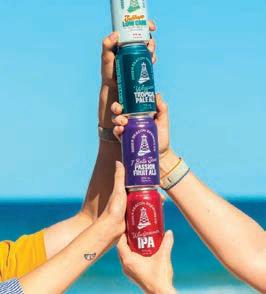

Barnes & Brown is a rising force in the non-alcoholic spirits industry. Co-founder Tim Brown discusses how the brand began, where it’s heading, and why the sector is maturing.



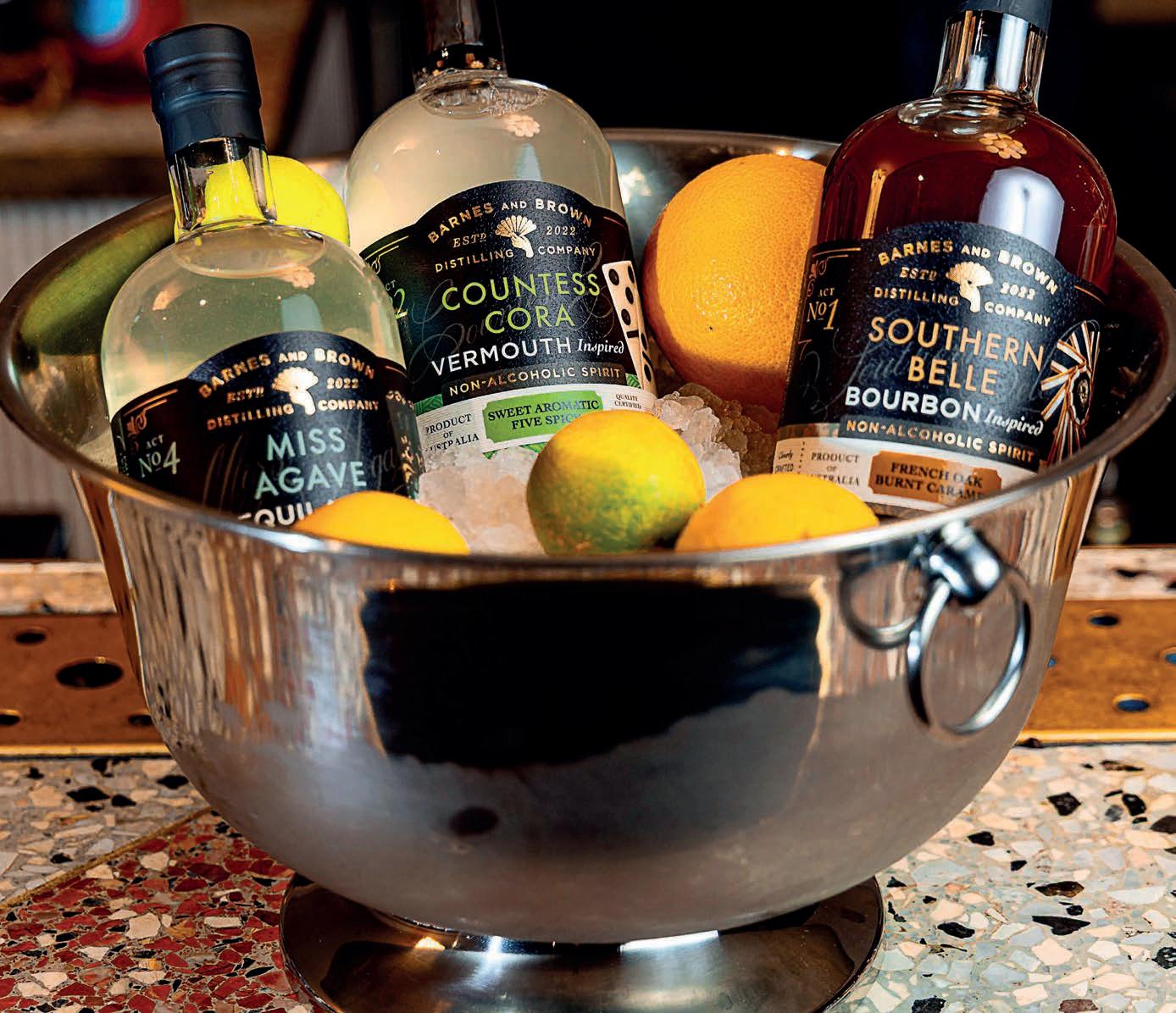
When Tim Brown set out to create Barnes & Brown, it wasn’t because he had a background in beverage manufacturing. In fact, it was quite the opposite. He had worked in retail and distribution, selling alcoholic drinks, before discovering the scale of the opportunity in the non-alcoholic space. Brown saw a clear market gap: high-end nonalcoholic spirits that weren’t simply sugary mixers but could stand tall on their own, emulating the flavour complexity of alcohol-based spirits
What began as an observation turned into a mission.
“I think a lot of people are surprised when they find out I don’t come from a distilling background,” Brown said. “But that worked in our favour. We weren’t tied to the old way of doing things.”
He spoke candidly about the moment the idea crystallised. Having visited a number of cocktail bars and bottle shops, he realised that while beer and wine alternatives were becoming more available, nonalcoholic spirits were still in their
Determined to approach things differently, he assembled a team of food scientists and mixologists who could help reverse-engineer the sensory characteristics of traditional spirits. Their goal was to build something credible, not just in terms of flavour but also branding. They wanted a product that bartenders would want to work with, not something that sat on the shelf gathering dust, Brown said. From day one, Barnes & Brown was designed as a premium option. Packaging, formulation, and flavour notes were all

Building a non-alcoholic spirit isn’t as simple as removing alcohol from an existing formula. It’s about rethinking the very structure of a drink. Brown explained that one of the major hurdles is replacing the mouthfeel and complexity that ethanol typically provides. Alcohol isn’t just an intoxicant, it’s a carrier for flavour and aroma. Without it, many ingredients fall flat.
The Barnes & Brown approach involved layering botanical extracts in a way that mimicked the complexity of spirits. Brown said it was an iterative process, involving constant trial, tasting and refinement. Early versions, he admitted, weren’t always successful. He even openly admits that some of the first ones we made were “terrible”. They were either too bitter, too thin, or just plain weird. Over time, the team developed what Brown describes as “a new language of flavour” – one not anchored to alcohol, but still capable of evoking the same emotions and experiences. He is quick to point out that its drinks are not designed to trick the palate or replicate a specific brand. Instead, they aim to create something that feels grown-up and well-rounded. Brown said their most popular product has juniper and citrus notes but also includes earthy and peppery tones that make it feel familiar yet new.
The company’s core market might seem obvious; people who don’t drink. But Brown said that isn’t entirely accurate.
“The majority of our customers still drink alcohol,” he explained. “They’re just choosing not to drink all the time.”
For Barnes & Brown, the sweet spot is the so-called “moderation movement”; consumers who enjoy the ritual of drinking but want a break from booze. Brown said he sees this in the diversity of their customer base. From young professionals trying to reduce mid-week drinking, to older customers seeking better health, to pregnant women and designated drivers, the brand has found resonance across demographics. Brown believes it is about inclusion and that everyone should be able to enjoy a good drink, regardless of what’s in it.

The hospitality industry, he said, has also evolved. Whereas once nondrinkers were fobbed off with soda water or sugary mocktails, venues are now recognising the value of premium alcohol-free options.
“It’s about giving people a reason to stay,” Brown said. “If someone’s not drinking, they shouldn’t feel like a second-class guest.”
Retailers, too, are beginning to change their layouts. Barnes & Brown is often stocked not in the soft drink aisle, but in the spirits’ section. Brown believes this signals that this is a serious product. He said it deserves to sit alongside gin, vodka, and rum. That positioning has helped the brand appeal to bartenders and serious home mixologists alike.
The journey from prototype to national brand wasn’t straightforward. Brown described the early days as “chaotic”, making small batches,
testing them with friends, and tweaking the formula. The breakthrough came when they partnered with a co-manufacturing facility that understood the sensitivity of their ingredients and could handle the process at scale.
“Our production methods are very specific,” Brown said. “We use a combination of heat and cold extraction, and the order in which we add ingredients really matters. Scaling that up was no small feat.”
Finding the right supply chain partners was essential. Barnes & Brown now works with a network of producers, designers and logistics providers, each aligned with the brand’s mission.
The business remains independent and founder-led, something Brown sees as a major strength.
“We’re small, but we’re agile,” he said. “If we want to make a change to a recipe or try a new product, we can do that quickly.”
While some non-alcoholic
brands are funded by large alcohol companies, Barnes & Brown has stayed lean and focused.
Distribution is now growing steadily.
The brand has listings in major bottle shops and is featured on the menus of several well-regarded cocktail bars. Brown said that while they’ve had international interest, their focus remains domestic for now. It wants to make sure it can serve the Australian market properly before it gets too far ahead of itself.
Brown believes that the nonalcoholic industry is only just getting started. Although there’s been a flurry of new brands and growing consumer interest, he said the category is still young and evolving fast. He thinks the industry is where craft beer was 20 years ago and there’s a lot of excitement, but also a lot of confusion.
One challenge is defining what
non-alcoholic spirits actually are. Unlike beer or wine, which have clear reference points, many consumers still don’t know what to expect from a non-alcoholic gin or rum. Brown said education is key. He and his staff spend a lot of time talking to bartenders and customers, helping them understand how to use the product.
He also believes that better standards and clearer labelling will help. At present, definitions vary from country to country, and not all products are truly alcohol-free.
“It’s important for us that someone can drink our product and not worry about hidden alcohol content,” Brown said.
That transparency has helped build trust, especially among customers with health or religious reasons for avoiding alcohol. Brown said it also makes the brand more appealing to venues (and countries for that matter) with strict policies.

“For Barnes & Brown, the sweet spot is the so-called ‘moderation movement; consumers who enjoy the ritual of drinking but want a break from booze.”
Barnes & Brown is not standing still. Brown hinted at new products on the horizon, including limited-edition seasonal releases and a more experimental range designed for cocktails. He also said they’re exploring sustainable packaging innovations and working on new ways to engage directly with customers.
“We want to be more than just a brand on a shelf,” he said. “We want to be part of people’s rituals.”
To that end, the company has invested in events and collaborations with venues that support mindful drinking. Pop-up bars, tasting nights and education sessions are all part of the brand’s future strategy. Brown also reflected on the broader social changes that have helped the brand grow. He said people are asking more questions about what they consume. They’re looking for quality, for meaning, for balance. He believes the best non-alcoholic brands aren’t just copying alcoholic ones – they’re forging their own identities.
While growth is important, Brown is cautious about overextending.
“We don’t want to be everything to everyone,” he said. “We want to stay true to what we do best.”
That means sticking to their commitment to flavour, authenticity and design, and continuing to treat non-drinkers with the same respect as drinkers. In many ways, Barnes & Brown’s success reflects a cultural turning point. As the line between alcohol and non-alcoholic blurs, and as consumers become more intentional, brands like this one are helping redefine what it means to enjoy a drink. For Brown, that’s the whole point.
“We’re not anti-alcohol,” he said. “We’re prochoice.” F

We attach great importance to combatting climate change, feeding the world’s population and using packaging responsibly by ensuring resource-economical production and offering ecofriendly packaging solutions and efficient recycling innovations.
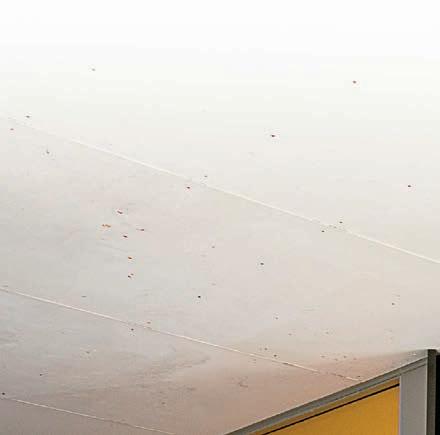
Beefy’s Pies, once a humble Sunshine Coast bakery, is now a growing national brand under Retail Food Group, with CEO Matt Marshall outlining plans for expansion.

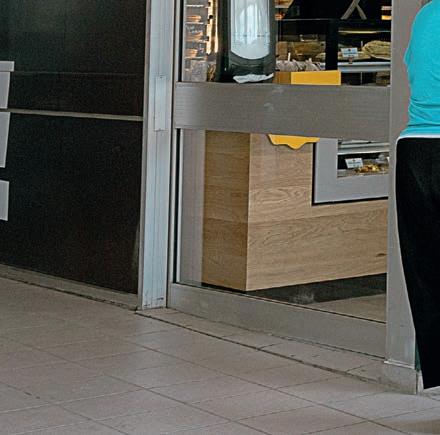

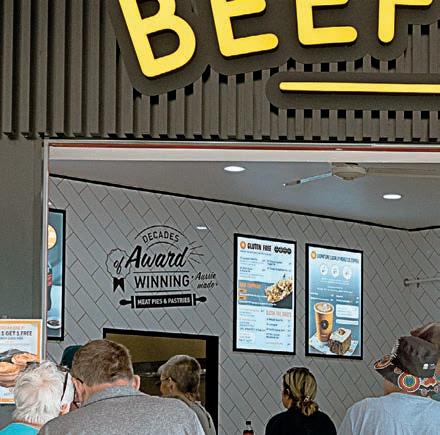

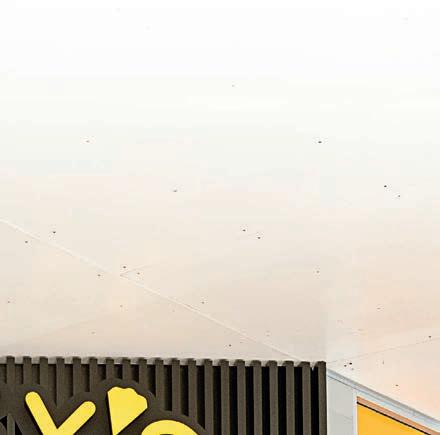
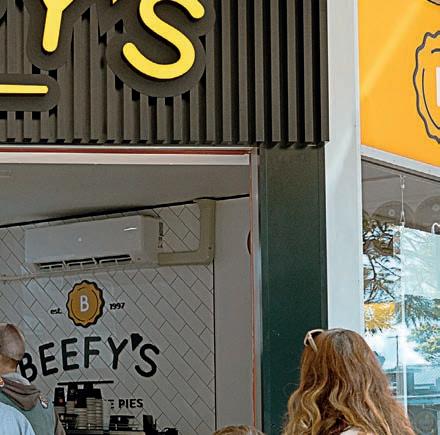



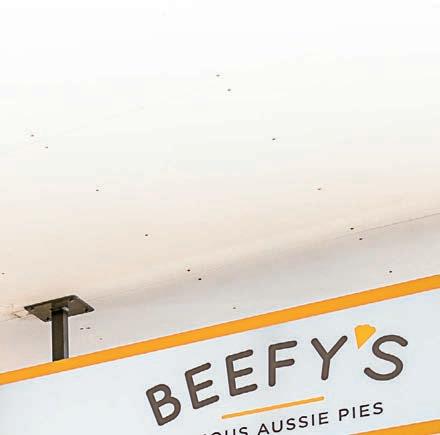

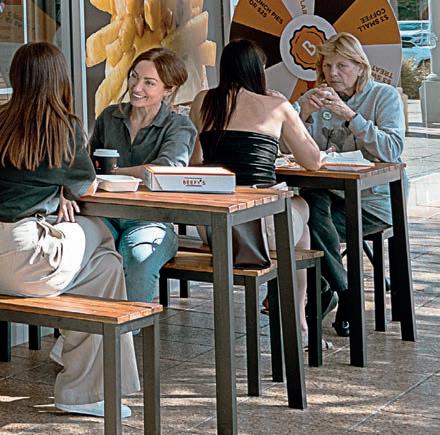



Beefy’s Pies began in 1997, founded by Ron and Shirley Hobbs on Queensland’s Sunshine Coast. Originally operating under the name Sunrise Bakery at the Aussie World precinct, the business focused on delivering traditional Australian pies with an emphasis on quality and locally sourced ingredients. Over time, it evolved into Beefy’s Pies and became a local institution.
The founders’ son, Mark Hobbs, inherited the business and continued its expansion across the Sunshine Coast. He also extended the product range, building an award-winning gluten-free portfolio in both savoury and sweet categories. In December 2023, Beefy’s was acquired by Retail Food Group (RFG), the parent company of well-known food brands such as Donut King and Crust Pizza.
Since joining the RFG portfolio, the business has extended into new territories, with stores opening in Ballina in Northern New South Wales, Newtown in Toowoomba, and Brisbane’s Cannon Hill and Capalaba. According to Retail Food Group CEO Matt Marshall, the acquisition

of Beefy’s represented a strategic investment in a brand with deep community ties and a proven track record of customer loyalty.
The Hobbs family, in launching Beefy’s, recognised an opportunity to do more than simply make pies. They saw the potential to elevate the Aussie meat pie by focusing on consistency, generosity, and premium Australian ingredients.
Marshall said the family’s commitment to sourcing local produce and delivering hearty, authentic flavours had long made Beefy’s popular. He described the business as “resonating with consumers seeking genuine meals grounded in Australian tradition” and praised the founding family for staying true to that vision over more than two decades.
Beefy’s success has not gone unnoticed. In 2020 and again in 2021, its Gluten Free Steak, Bacon & Cheese Pie was named Australia’s Best Gluten Free Pie at the Official

Great Aussie Meat Pie Competition.
“These accolades are a testament to the brand’s dedication to meeting the evolving needs of customers without compromising on taste or quality,” said Marshall.
The business has continued to invest in its gluten-free product line, which has become a hallmark of the brand.
That focus has helped grow Beefy’s into a destination for customers
As the company expanded, the need for reliable, high-volume production became clear. In 2002, Beefy’s moved into a manufacturing facility at Kunda Park on the Sunshine Coast. Since then, the site has been expanded and modernised to accommodate increased demand. While the exact details of equipment used remain proprietary, the business operates with the kind of high-
mixers, pastry sheeters, and pieforming machines,” said Marshall. “These tools are essential for maintaining consistent quality across multiple sites while still ensuring the signature Beefy’s texture and taste.”
That balance, between scale and craftsmanship, is one Marshall believes sets the brand apart. He said the facility’s layout and investment in technology allow it to “produce at scale without losing the handcrafted company’s sourcing philosophy. From the beginning, the business has prioritised working with local farmers and suppliers. Meats and produce are selected based on freshness, traceability, and regional sourcing. This not only supports Australian agriculture but also strengthens the brand’s integrity.
Marshall noted that this commitment is especially relevant in today’s market.
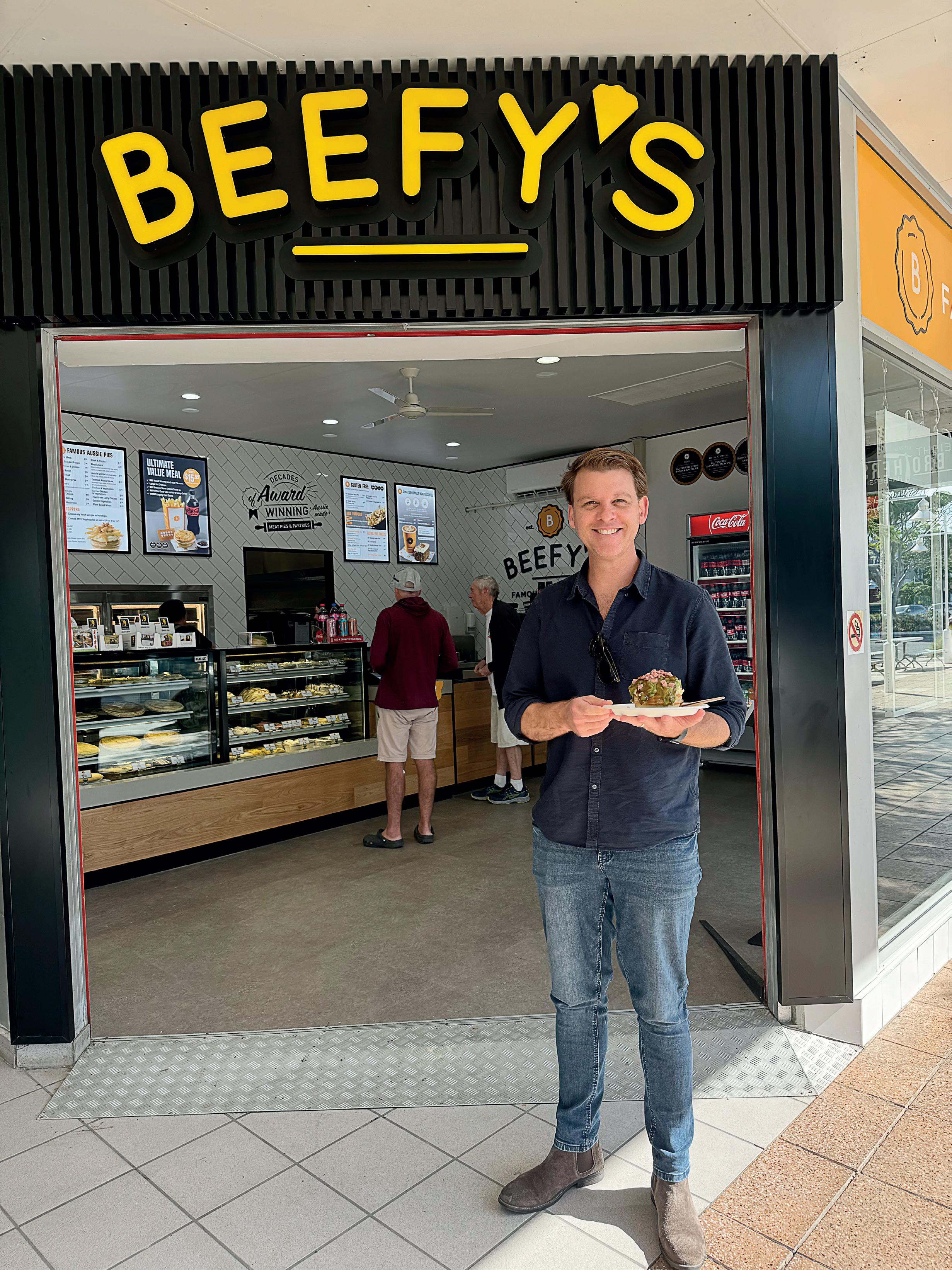
“Customers increasingly want to know where their food comes from. Beefy’s has always been ahead of the curve in offering that transparency,”
In the face of market pressures, Beefy’s has remained resilient. The bakery and QSR (quick-service restaurant) sector continues to be competitive, particularly with the rise of boutique independent bakeries. Despite this, Beefy’s has maintained a loyal following, something Marshall attributes to the company’s focus on quality and generous portion sizes. He acknowledged that the current business landscape poses a range of
manufacturers, we’re seeing increased pressure on beef pricing due to international demand, especially from China,” Marshall said. “At the same time, labour shortages and rising employment costs are impacting every part of the supply chain, from production to frontline
Marshall explained that while these pressures are mounting, Beefy’s is committed to working closely with suppliers to maintain quality
The business has also adopted a more agile approach to its menu and operations. Innovation, such as rotating limited-time product offers, which has helped counteract rising costs while offering something new
Digital channels have also become a growth driver. The brand has experienced consistent demand through food delivery platforms like Uber Eats and DoorDash, as well as its own online ordering system. These platforms allow Beefy’s to reach new customers without the immediate overheads of a physical store. Marshall said this model
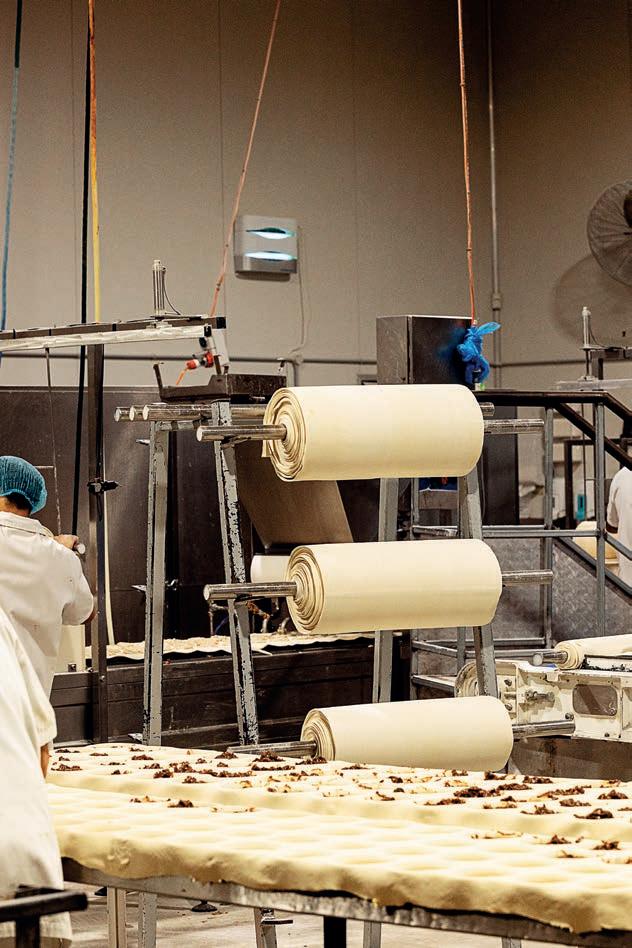
of “strategic digital expansion” is becoming increasingly important to the company’s long-term strategy.
What the sector must do next
Looking more broadly at the Australian foodservice and franchising sector, Marshall believes there are opportunities to do better. He pointed to the need for continued innovation in product offerings. Plant-based items, gluten-free lines, and allergen-friendly choices are increasingly important for modern customers and offer growth potential for brands willing to invest.
He also touched on the value of upgrading production technologies.
“Investing in modern manufacturing equipment can enhance both consistency and efficiency,” he said. “This allows
Beefy’s Pies continues to invest in its gluten-free product line.
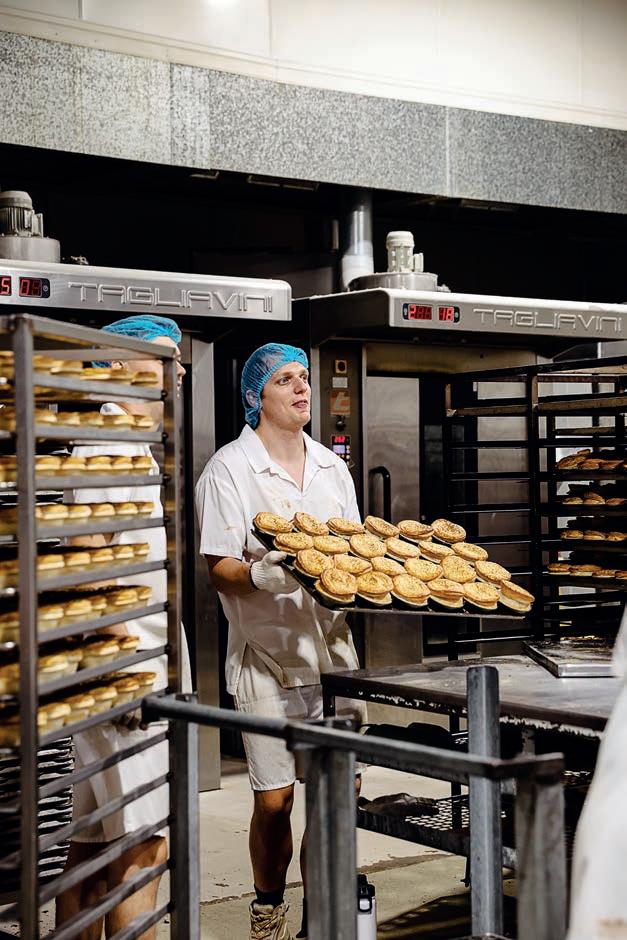
“Customers increasingly want to know where their food comes from. Beefy’s has always been ahead of the curve in offering that transparency.”
businesses to scale effectively without compromising on quality.”
But beyond product and operations, Marshall stressed the importance of policy settings. He said the franchising sector, which plays a vital role in economic growth, job creation and small business ownership, requires a stable and fair regulatory environment.
“There’s been a lot of uncertainty in franchising over recent years,” Marshall said. “We need a balanced framework that protects franchisees while also encouraging innovation and commercial viability. That balance is essential if we want to see continued
growth and investment in this sector.”
His comments reflect the broader goals of RFG, which seeks to create an environment where each of its brands, whether pizza, doughnuts, or pies, can scale sustainably and support local ownership.
Since the acquisition by RFG, Beefy’s has been moving quickly but carefully. The new stores in Ballina, Toowoomba, and Brisbane reflect a growing appetite for the brand in regional and metro areas alike. Each opening has been supported by local promotions and community engagement, including pie drives and special offers, which are designed
to introduce new customers to the Beefy’s experience.
While expansion will continue, Marshall is focused on measured growth. Future locations will be guided by customer feedback, sales data, and demographic insights.
The company is also looking at ways to enhance its drive-thru model and experiment with digital loyalty programs.
Marshall described Beefy’s as a brand with “enormous potential” that still feels close to its roots. He said the plan is not to reinvent the business but to support it and therefore help extend its reach while preserving its identity.
“We’re not here to change what makes Beefy’s special,” he said. “We’re here to provide the support and scale needed to take it to more customers.” F
True sustainability in packaging demands a full-circle approach, from production to reuse to responsible disposal.

Over the years, the food industry has seen a shift towards a more sustainable future. While efforts contributing to a healthier food industry have shown positive results, there are gaps in the process that industries often overlook – packaging.
When it comes to packaging, industries remain reliant on singleuse plastic. Beyond affordability and functionality, research and product development to replace plastic has been slow.
For example, wooden cutlery has become more common in fast food restaurants and supermarkets. While this is a step in the right direction, phasing out problematic, single-use materials is still taking time, according to Nasim Aflatoon, sustainability manager at Bunzl Asia Pacific.
She addressed the gap in recycling infrastructure as one of the barriers to progressing towards a sustainable future.
“Infrastructure for reusable and circular systems are emerging in Australia,” said Aflatoon. “Although some options are available in the market, lack of accessible collection points can present challenges.”
However, this is not to say that the efforts by individuals, governments, organisations and industries dedicated to sustainability are futile.
Australia has seen improvements by lowering its carbon footprint and emissions, reducing food waste, and innovating low-impact technologies to produce food efficiently without further harming the environment.
Bunzl takes it further by not only applying sustainable practices
internally but also extending them to its products, partner industries and consumers.
While every individual has a role in sustaining the planet, industries have a responsibility to inform their customers and encourage participation.
From material traceability and data collection to navigating regulatory frameworks, various challenges continue to stunt the growth of sustainability in Australia. According to head of marketing and ecommerce at Bunzl Australia and New Zealand, Fiona Corsie, inconsistent requirements across states create confusion for customers.
“Our colleagues on the
sustainability side spend a lot of time informing the customer as to what those government frameworks actually mean for them in their location,” said Corsie.
Working closely with governments and government bodies, the team addresses queries from customers trying to navigate labelling, recycling, low-impact materials and solutions, with the goal of reducing overall waste.
Bunzl’s reusable and recyclable Katermaster Regen food container aims to support this mission by offering environmental benefits through consumer-friendly features.
Katermaster Regen is Bunzl Australia and New Zealand’s food service solution brand. Its products cater to customers seeking durable kitchen
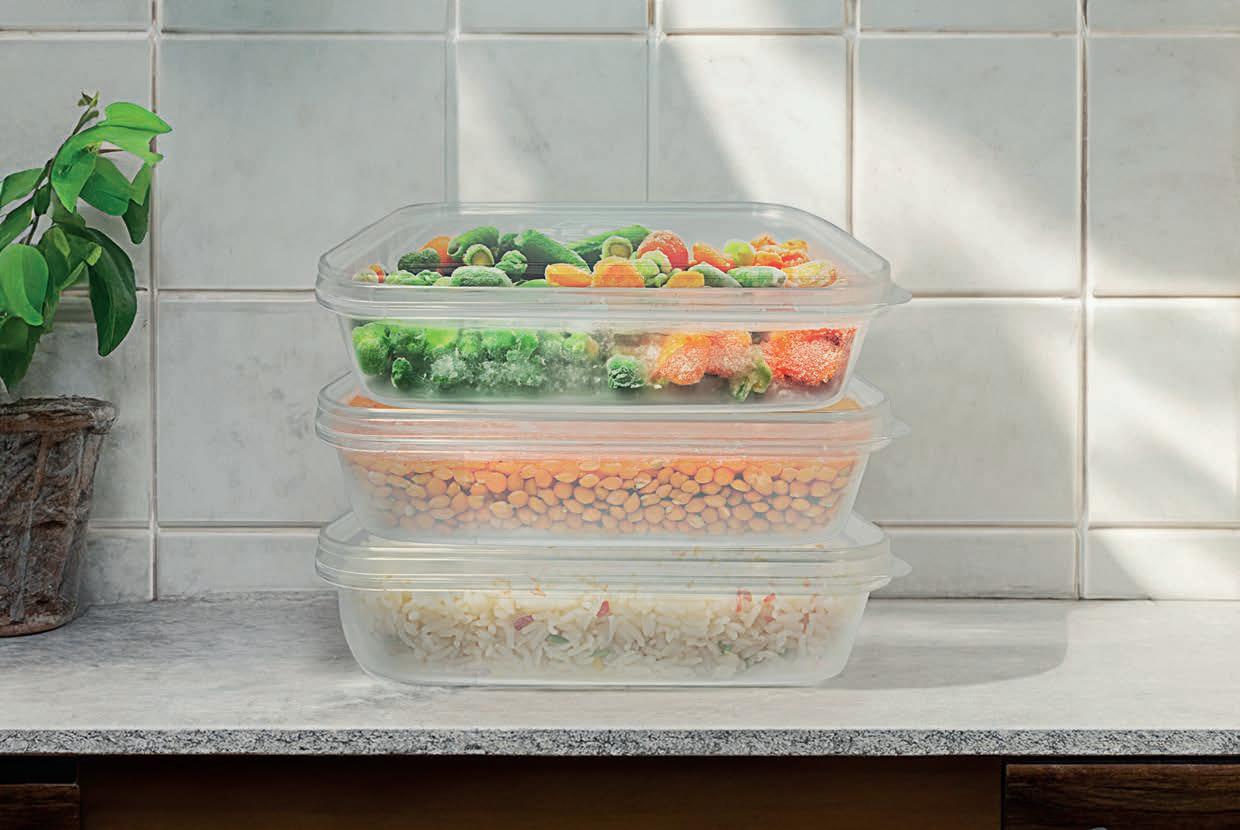
The Katermaster Regen is cost-efficient, reusable, and recyclable.
and food service options.
It is a locally manufactured product that received gold at the 2025 Australasian Packaging Innovation and Design (PIDA) Awards for Sustainable – Reuse and Refill.
The reusable container withstands up to 700 commercial washes and is designed for long-term use. However, longevity is only the beginning. While durability is a key selling point, it should not be the sole factor when selecting materials.
Aflatoon explained that the team assessed every stage of the product’s lifecycle. She noted the container’s microwaveable and refrigerable features, and its kerbside recyclability when it reaches end of life.
“Manufacturers often design a product without thinking how it will be recycled or disassembled,” said Aflatoon. “They use multiple materials within a product, which makes it difficult to separate and recycle.”
“Bunzl looks for products that have a good start of life story all the way through to the end of life, making sure it’s the easiest to repurpose, reuse, and recycle,” added Corsie.
The Katermaster Regen is made from polypropylene (PP) monomaterial, which is integral to its lightweight, heat-resistant, and
“Bunzl looks for products that have a good start of life story all the way through to the end of life, making sure it’s the easiest to repurpose, reuse, and recycle.”
food-safe properties. PP is also cost-effective for high-volume manufacturing, making it a preferred choice for streamlining supply chains.
Combined with its affordability and durability, it offers a practical alternative for customers transitioning from single-use products.
The container includes the Australian Recycling Label (ARL), which provides clear instructions for proper disposal – helping consumers adopt better recycling habits and reduce the environmental impact of food packaging.
With increased use and user feedback, Bunzl hopes to continue developing innovative packaging solutions that support a more sustainable future.
By informing customers and selecting PP monomaterials, Bunzl’s Katermaster Regen ticks off the
boxes of processes that feed into the broader picture of sustainability.
Bunzl collaborates with local Australian manufacturers, aiming to make a positive contribution to the environment and the broader food industry.
Genfac Plastics is an Australianowned plastic food packaging manufacturer. The business has 30 years of experience with the goal to deliver low carbon footprint and quality recyclable products, such as the Katermaster Regen.
With aligning ethical values, the partnership between the two companies helped nurture the growth of environmentally conscious decisions and products.
“Genfac Plastics generates 15 per cent of production electricity needs from its roof-top solar farm,” said Aflatoon. “By working with local suppliers, you’re not just supporting the Australian manufacturing industries and jobs, you also reduce international transport emissions, lead times and
risk of supply chain disruptions.”
Aflatoon noted that transport emissions are among the highest contributors to global emissions. Local material sourcing and production can help reduce emissions associated with transport. Due to the locality of the business, quality control can also be managed easier.
Bunzl has a unique role in the supply chain, Corsie added. While most manufacturing companies find limitations caused by fixed machinery, Bunzl has an advantage to flexibly source sustainable packaging solutions that customers are after.
“With Katermaster Regen, around 18 months of work went into finding a manufacturer that could meet the requirements of what we were after, work with the material that we were after and provide the end of life we required,” said Corsie.
As packaging demands grow alongside advancements in food technology, it is imperative to research and develop solutions that take a full-circle approach — including the end-of-life stage of the product.
Bunzl’s approach serves as a catalyst for advancing Australian manufacturing and guiding the food and beverage sector toward a sustainable future. F
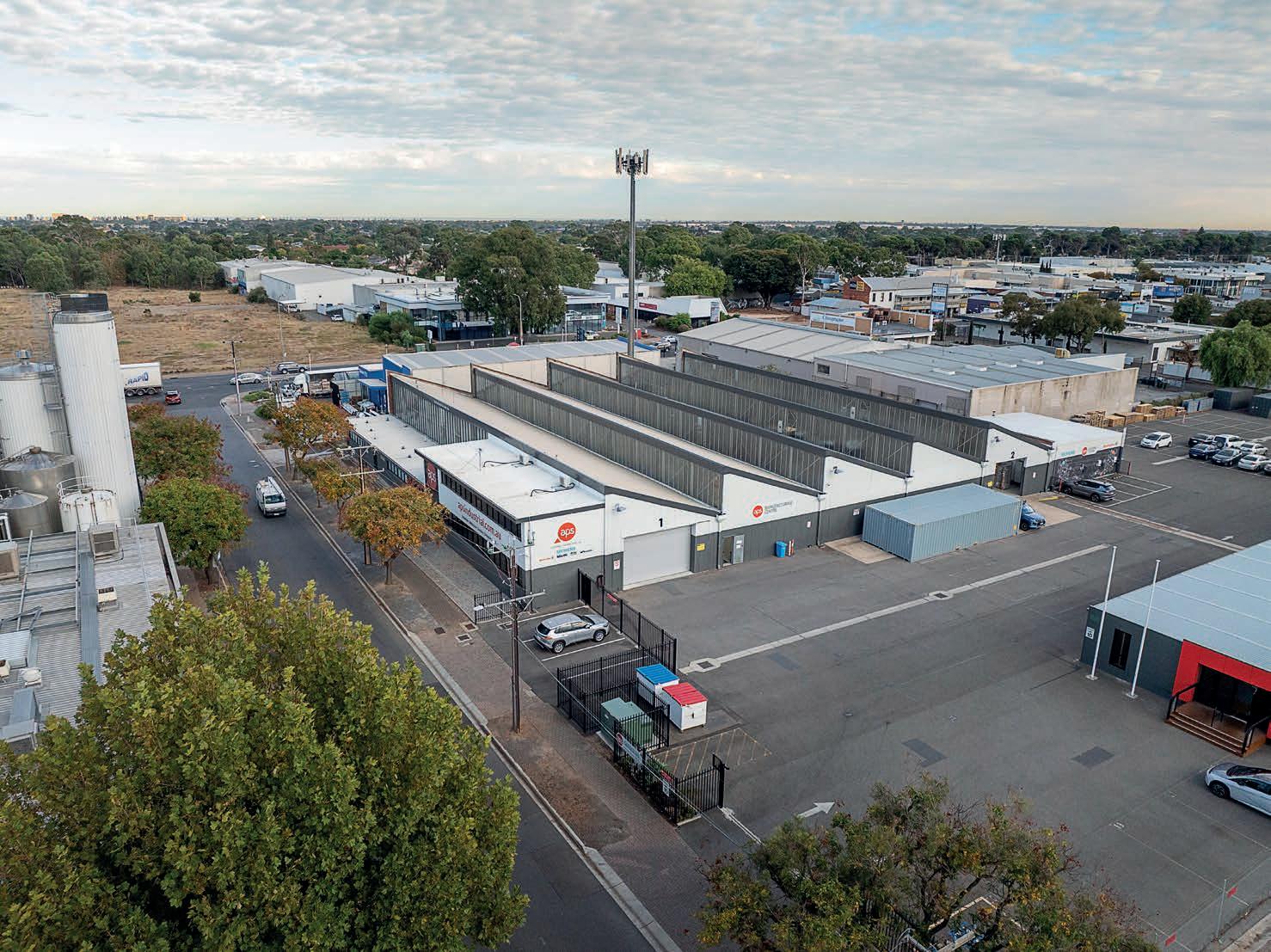
To stay competitive in the food and beverage manufacturing market, futureproofing a business is encouraged. To make this a possibility, a modern and innovative manufacturing site is imperative.
APS Industrial has announced a new agency agreement with engineering software provider Eplan. Eplan develops software solutions that support integrated design processes in electrical, automation and mechatronic disciplines.
This strategic partnership enables APS to incorporate Eplan’s capabilities into its own operations and to offer these tools to Australian food and beverage manufacturers. Customers will benefit from design accuracy, enhanced documentation, and efficient communication throughout project lifecycles.
The partnership is directly enabled through APS’ facility that supports digitalisation, efficiency and customisation.
APS Industrial’s Manufacturing Centre in Adelaide is raising the bar for advanced manufacturing in Australia through value-added services and tailored solutions for the Australian food and beverage sector. Purpose-built to streamline delivery and enhance product customisation, the facility exemplifies what modern manufacturing can achieve when innovation, efficiency and local capability are prioritised. In today’s competitive climate, where speed and adaptability are crucial for success, APS’ facility shows how an integrated manufacturing approach can respond to market demands without compromising quality or service.
Through the combination of advanced hardware and sophisticated software technologies, APS delivers high-performance outcomes across a range of services. These include air circuit breaker (ACB) adaptation, precision printing, terminal rail cutting and automated panel assembly. Every element is designed to reduce production time, cut costs, and empower local food and beverage manufacturers to grow with confidence.
A key strength of the Centre is its ability to support Australia’s local industries in managing their energy needs. The centre is not just a warehouse or an assembly line – it is a technology hub where digitalisation plays a role in optimising efficiency and output. Through data-driven
processes and a commitment to excellence, APS continues to raise expectations in local manufacturing.
In an industry that relies on highspeed production and operational consistency, the ability to deliver high-quality components quickly and reliably is essential. APS has developed its facility to minimise delivery timeframes while providing flexible, customised components built to exacting standards.
For example, by reducing reliance on overseas production and delivery cycles, APS helps local producers respond more quickly to shifting demand. This is especially valuable for food and beverage businesses
that operate on tight schedules and rely on dependable, uninterrupted energy supplies
Through a strong partnership with Siemens, APS has made contributions to South Australia’s Advanced Manufacturing Strategy. This includes bringing to life a local adaptation centre for Siemens air circuit breakers, which serves both Australian and New Zealand markets. The company’s manufacturing capability extends beyond the basics, delivering end-to-end solutions that are faster, smarter and more efficient.
Air circuit breakers are a critical component in ensuring reliable electricity supply across many sectors, particularly in manufacturing, mining, commercial property and infrastructure. ACBs not only prevent electrical overloads and equipment damage but also contribute to the energy transition by supporting stable and secure power networks.
APS’ facility includes a Siemenscertified Adaptation Centre – the first of its kind globally outside of Siemens
itself. This centre allows APS to locally adapt and assemble Siemens SENTRON ACBs, reducing typical delivery times by up to 50 per cent. This faster turnaround benefits local switchboard builders and electrical contractors who depend on consistent and immediate access to high-performance power protection systems.
By supporting the ACB lifecycle from assembly to local service and support, APS improves cost control, reduces lead times, and gives customers access to critical infrastructure without the delays typically associated with international supply chains.
APS also provides a complete suite of custom-designed distribution boards (DBs), developed with a deep understanding of the needs of the Australian food and beverage industry. These DBs are built to deliver durability, compatibility and convenience.
The APS ‘DB family’ range is designed to work seamlessly with Siemens circuit breakers, providing a
reliable, high-performance electrical solution for complex production environments. The flagship ‘DB Ultimate’ range features a removable, one-piece internal frame that allows assembly and wiring independent of the enclosure itself.
This design allows for greater flexibility during installation, servicing, commissioning and retrofitting, making it suitable for evolving production environments where equipment upgrades and reconfiguration are common. The range supports modular thinking and long-term efficiency for end users.
The Centre is more than just a production site – it is a blueprint for the future of advanced manufacturing in Australia. Every process, from machining to assembly to software integration, reflects the company’s mission to empower local industries with premium technology and reliable service.
By offering local access to Eplan’s digital engineering solutions, APS
is setting a precedent for smarter, software-enabled manufacturing in Australia. This collaboration gives food and beverage businesses the opportunity to harness advanced engineering tools without navigating the complexity of multiple systems or offshore support networks.
By building its facility around the principles of digitalisation, efficiency and customisation, APS is helping Australian food and beverage manufacturers stay competitive in a fast-changing global economy. This commitment ensures that customers receive not only high-quality products, but also the long-term support and service needed to thrive in the years ahead.
The centre showcases what is possible when local capability is aligned with global standards and backed by partnerships with Siemens and Eplan. F
To learn more about APS Industrial’s Manufacturing Centre and its contribution to Australian manufacturing, visit: https://apsindustrial.com.au/ manufacturing-centre.

With tailored support and smart technology, Fishbowl helps food and beverage businesses navigate inventory challenges.
In the food and beverage sector, meeting industry compliance needs is becoming more demanding as businesses try to juggle and balance other operational and ancillary tasks. When asked about the current challenges food and beverage businesses face, managing director of Fishbowl Inventory Asia Pacific Simon Jupe described the poor systems surrounding inventory in warehousing.
“If you don’t have a good inventory system, the subsequent reporting
requirements that you need to be compliant in the food and beverage industry becomes hard to meet,” he said.
For many food and beverage manufacturers, inventory management is often a behind-thescenes function, but it plays a critical role in efficiency, compliance and customer service.
Whether businesses are supplying to big or small retailers or simply trying to meet basic hazard compliance, efficient processes need to be set in place to build quality control and a
strong reporting framework.
Fishbowl, a software company specialising in inventory and manufacturing systems, helps food and beverage businesses navigate compliance, traceability and operational challenges. Founded in the United States in 2001, the company launched into the Australian and New Zealand market in 2011. Working closely with a range of industries including food and beverage for more than two decades, Fishbowl focuses on making inventory and manufacturing operations more streamlined.
As Fishbowl provides an off-the-shelf inventory package, businesses in the food and beverage industry look for assistance in traceability. Traceability is one of Fishbowl’s core strengths. In highly regulated sectors like food and beverage, being able to track products and ingredients across the supply chain is vital.
For the food and beverage sector, the work that goes into inventory costing and operational requirements around inventory can be challenging.


Fishbowl aims to help businesses meet regulatory compliance standards while improving accuracy and efficiency. One of the issues food manufacturers face is working with spreadsheets. Many begin with manual tracking systems that gradually become elaborate collections of Excel files.
Over time, these tools can become inconsistent. Jupe explained that spreadsheets often create problems.
“While spreadsheets are brilliant in business, they are brittle,” he said.
Technical issues caused by version control, broken formulas, inconsistent data, absent staff or incorrectly updated systems are all variables that leave consequential gaps in business inventory systems.
Fishbowl addresses these issues by providing a centralised system where purchasing, production and sales processes are managed in one place. This eliminates duplication and fragmentation. All information flows through a single system, allowing real-

time reporting and visibility.
“Fishbowl brings all the operations from purchasing, production and sales into one system,” said Jupe.
While Fishbowl offers an offthe-shelf inventory package, it has reporting functionality tooling enabling the building of both custom forms and templates directly in the software.
By streamlining processes into one system, Fishbowl enables manufacturers to deliver accurate reports and respond quickly to quality control issues.
“The value comes from having one standardised central repository of the whole business operations, rather than bits and pieces coming from multiple sources,” he added.
The software covers a range of users, from sales and operations teams to warehouse staff and production managers. It handles quoting, order processing, picking, packing and shipping, while also managing procurement and manufacturing workflows.
Another advantage is the flexibility Fishbowl offers in its service approach. While the software itself is off the shelf, the implementation and support services are tailored to each business. For complex industries like food and beverage, face-to-face interaction remains valuable.
In Jimba Lamb’s case, a brand of premium Australian lamb, the company required assistance to solve a unique inventory challenge.
As a new division of United Meat Co, Jimba Lamb was building its system from scratch. In order to find a solution, it required a collaborative approach.
Compared to other businesses that invoice before picking and packing, Jimba Lamb has a process where it sells by the box and charges per kilogram. As every box weighs differently, an invoice could only be determined after the inventory is picked. To tackle this issue, the company had to search for customisable solutions that allowed seamless integration with Xero to keep their financial reporting consistent.
Fishbowl works closely with clients, iterating and expanding the software’s use as the business grows. Once that foundation is in place,
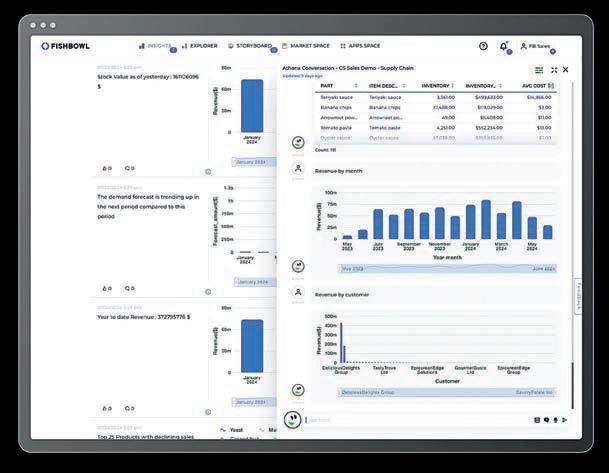
businesses often move on to explore more advanced features.
“Engaging in more complex industries or requirements like food and beverage, it is advantageous for us to actually have face-to-face contact,” said Jupe.
Using Fishbowl’s legacy ERP product, Jimba Lamb was able to co-develop a solution that could generate invoices and picking slips simultaneously tailored to its box-to-kilo process. Also, due to the locality of Fishbowl, Jimba Lamb was able to evolve into using newer technology such as Fishbowl’s AI reporting platforms to boost visibility across the entire team from sales to transport crew.


customer expectations and efficiency demands, Fishbowl’s tools provide clarity and control. Whether the goal is to reduce waste, improve costing, or ensure consistent quality, having the right systems in place is essential.
As each company has its own set of needs and processes, Fishbowl dives deeper into those industries to provide flexible services with fixed products.
Jupe spoke about a yoghurt company that uses Fishbowl’s software. He described that the way they utilise the software differs from other companies such as meat manufacturers based on their factory layout, staffing or resourcing availability.
He emphasised that while Fishbowl does not use a “one-size-fits-all” approach, it customises its service, which allows them to work with customers long-term.
As manufacturers continue to face pressures from compliance,
While food and beverage companies approach Fishbowl for its expertise surrounding traceability and compliance standards, Jupe addressed how they uncover other avenues to grow through its products. By witnessing the value of the products that can assist with production costing and analysis, Fishbowl then collaborates with customers through in-person or remote offerings to optimise their warehouse processes.
For companies like Jimba Lamb, working with Fishbowl has meant more than just software. It has been a journey of operational transformation supported by local consultants and a system that grows with the business. F
As Australian manufacturing continues to embrace innovation, the 2026 Endeavour Awards will highlight the companies and individuals driving change in the food and beverage sector.
Awards and certificates are not just displays to be placed on bookshelves or hung on walls to collect dust. They mark milestones, passion, and growth from the innovative minds who pour their efforts into the shared goal of building communities. From technologies to manufacturing capabilities, it is important to pause and show appreciation, celebrating achievements and acknowledging how far businesses have come.
Specifically in the food and beverage sector, manufacturing capabilities are being modernised to align with the digital landscape. Winning the Best Technology Application Award and Australian Manufacturer of the Year at the 2024 Endeavour Awards, MEQ celebrated its efforts to boost Australia’s food sector.
Presented annually by Manufacturers’ Monthly, the Endeavour Awards are the premier national awards programme recognising outstanding achievement in the Australian manufacturing industry.
MEQ builds solutions across both production and processing by generating data through its advanced hardware.
With a focus on animal protein and the global red meat industry, the company aims to deliver new insights through customer data.
Remo Carbone, chief executive officer and co-founder of MEQ, expressed the team’s pleasure in celebrating their success at the Awards.
“It was great recognition for the team,” he said. “Everyone was super pleased to be there and be a part of it.” The award submission was based on MEQ LIVE, an agriculture-focused technology that allows breeders, farmers, feedlot operators and sale yards to measure the meat quality and yield of a live animal while reducing carbon emissions within the industry.
MEQ LIVE can unlock blind spots in livestock production systems. Its solution allows producers to predict end processes for managing animals as far as 400 days in advance.
Although the company has been operating for nine years, the first six were focused purely on research and development. Carbone acknowledged the challenging beginnings of building revolutionary technology from scratch.
“We had to find a way to build hardware that had never existed before,” he said.
Carbone described the difficulty of combining different types of hardware and software at a machine learning level while proving the product’s value to the market.
Nevertheless, the company’s clear direction and perseverance kept the team committed. Recognising a blind spot within the engineering and entrepreneurial communities regarding animal protein production, Carbone described not only the technical but also the commercial challenges of building a categorydefining business in a largely overlooked space.
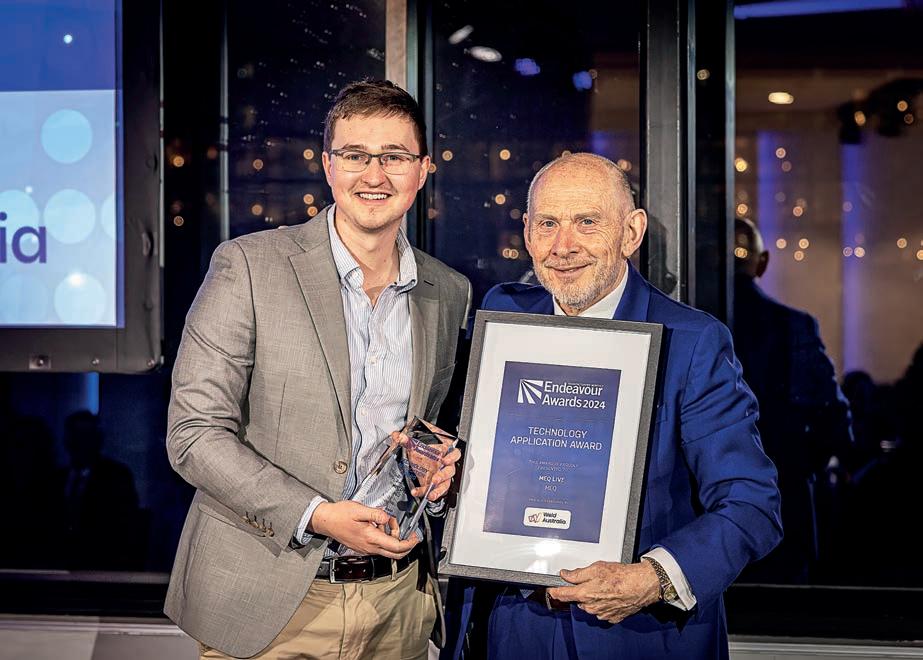
One of the most effective ways to catalyse growth in Australian manufacturing, according to Carbone, is through interactions between creative problem solvers who are striving to make a meaningful impact.
With determination and vision, the business evolved into a thriving operation with a growing deployment base and activity in six countries.
“It has been quite a journey,” said Carbone. “Australia may have a high cost of labour relative to other countries, but we have all the ingredients to double down on advanced manufacturing.”
With events like the Endeavour Awards, Carbone emphasised the importance of recognising and supporting companies in their early stages as they take bold steps toward innovation.
Connecting with other advanced manufacturing leaders, both within and outside the food and beverage sector, gave the MEQ team the opportunity to step beyond its internal focus and engage with a broader, appreciative community.
Staying aware of each other’s progress and remaining engaged in these peer networks can lead to new opportunities and collaborative efforts.
The Endeavour Awards Gala is a celebration of innovation, resilience, and excellence across the manufacturing sector.
“I’d love to see more companies being present at the Endeavour Awards,” Carbone concluded. “We’re trying to help build the ecosystem in relation to advanced manufacturing in Australia.”
For the first time in the award’s history, there will be a dedicated Innovation in Food Manufacturing Award. This new category celebrates innovations that enhance food and beverage production and is open to
businesses developing new solutions in processing, packaging, automation, or sustainability.
Now more than ever, it is essential to support and champion local food manufacturing. This is an opportunity to acknowledge those making a real impact, whether by driving innovation, supplying vital products or services, or leading their organisations with vision and determination.
Next year’s award categories include Technology Application Award (Sponsored by Weld Australia); Innovation in Aerospace; Innovation in Health Technology; Innovation in Food & Beverage Manufacturing; Innovation in Transport; Outstanding Start-Up Award; Leader of the Year (Sponsored by BDO Australia); Manufacturer of the Year.
To be eligible, innovations must be newly introduced to the market or significantly advanced within the two years prior to the nomination closing date. F
Technology group Krones is working closely with customers to deliver future-ready production lines and technologies tailored to every step of the beverage process.
In the diverse food and beverage industry, every operation has its own set of unique processes and needs. Some businesses work with complete turnkey lines, while others operate with single machines or partial systems.
Depending on these requirements, most beverage products go through several processing stages. For businesses working with in-built systems, the challenge lies in finding automated and integrated solutions to streamline operations and meet production targets.
Krones is helping food and beverage producers modernise their operations while staying competitive in high-cost markets such as Australia and New Zealand. It offers a range of solutions, from standalone machines to integrated turnkey production lines.
Founded in 1951, the familyowned company has evolved into a global technology group with tailored solutions for every stage of production. With nearly 20,000 employees worldwide, Krones has built a strong reputation in beverage manufacturing.
In this sector, flexibility and customisation are essential. Krones delivers tailored factory planning
services that enable partial or full upgrades, based on each client’s specific needs.
From container production, filling and packaging to recycling, the company can provide solutions for individual components such as blow moulders, palletisers and fillers, or full processing and packaging lines.
Reducing downtime and cutting production costs are key goals in manufacturing. By improving output through smarter systems, workflows can be optimised without the need for excess inventory. Storage space is preserved, and resources can be used more efficiently.
With a focus on staying responsive to market trends, Krones integrates new technologies and digital tools into its offering. Franz Kirchberger, head of sales at Krones Pacific, said the company’s systems are designed with flexibility and future readiness in mind.
“Krones has a lot of AI solutions that are being offered to make machines more reliable,” said Kirchberger.
He noted that customers across Australia and New Zealand are embracing automation as they recognise the cost pressures of local manufacturing. To achieve optimal
results, businesses are increasingly adopting automation in their packaging lines, particularly in PET systems.
While trends differ across regions, PET continues to grow in the AsiaPacific, driven by population growth and rising demand. Krones supports this demand with equipment suited to a variety of packaging formats, including PET and aluminium cans.
New tools powered by artificial intelligence are helping improve machine reliability, reduce the need for manual intervention, and increase overall production efficiency. The upcoming drinktec 2025 exhibition in Munich, Germany, will showcase the best of what Krones has to offer.
“Automation is being considered in many areas where automation wasn’t considered before,” said Kirchberger. “Artificial Intelligence is making its way into packaging to make machines more reliable.”
He pointed out that automation is especially relevant in Australia, where high labour costs continue to influence capital investment decisions. He believes the local market is not far behind Europe when it comes to adopting digital and automated manufacturing solutions.
In addition to flexible systems for single machines or complete lines,
Krones puts a strong emphasis on building relationships with its customers.
“The customers are at the centre of our attention,” Kirchberger said. “Krones is focused on partnerships, rather than just transactional relationships.”
The company takes a partnershipbased approach by offering aftersales services, operator training, and access to spare parts through its online shop. Its local footprint is supported by a team of 20 service technicians across Australia and New Zealand, ensuring responsive and consistent support.
Looking ahead, Krones is targeting ambitious growth within the next few years. With innovation at the core of its development and a focus on customer satisfaction, Krones continues to grow as a beverage and liquid food processing and packaging solutions provider.
From consultancy to digital services, Krones takes an integrated approach to every project. It is committed to helping customers modernise their operations and move confidently toward a more sustainable future, while delivering the technical expertise needed to succeed in an evolving global market. F
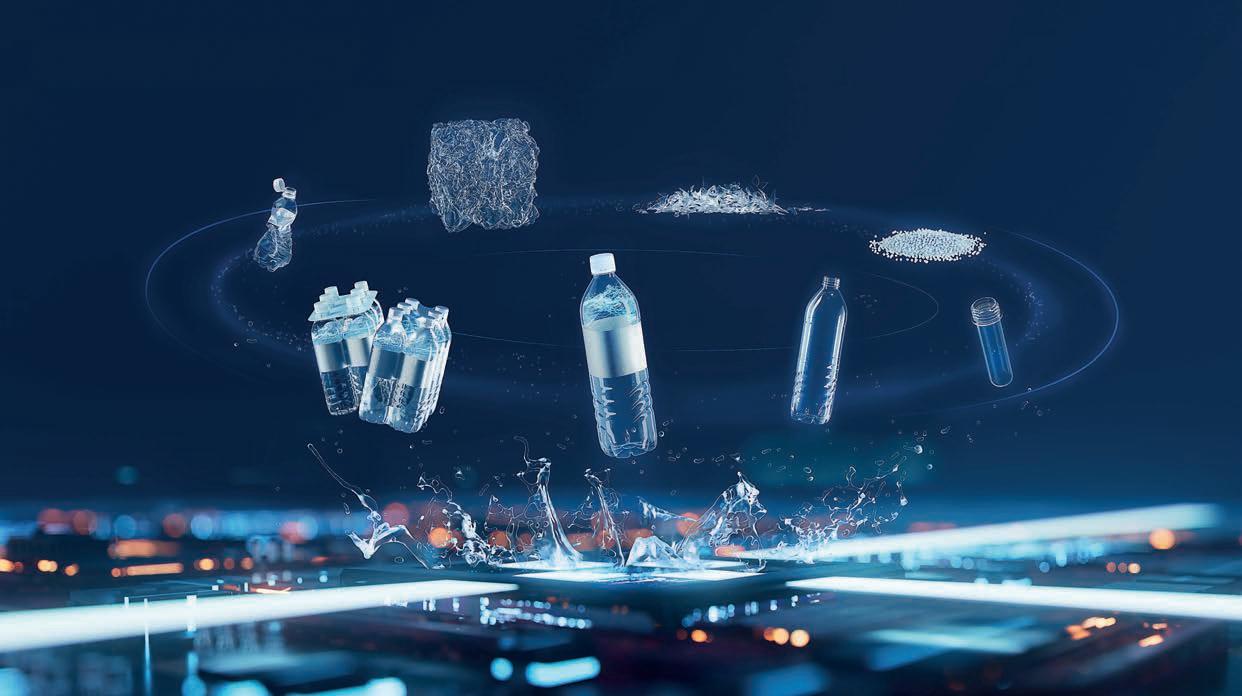
Born into a household of flavour and quality pastry, a second-year apprentice at Gumnut Patisserie is the third gold medal winner in his family at WorldSkills Australia’s National Championships (Patisserie Competition).

No competition is easy.
Speaking with an apprentice pastry chef William Nickl, it becomes clear that only the toughest and most highly trained trade professionals can compete and make a name for themselves in the sector.
Held from 12 to 15 June 2025, WorldSkills Australia delivered an electrifying National Championships. With more than 600 competitors going head-to-head across over 60 skill areas, the event drew more than 35,000 visitors in a celebration of Australian skills excellence.
Out of eight competitors in the Patisserie category, Nickl took home gold for his overall performance across a range of skills including a cheeky chocolate showpiece – a giraffe eating a flower.
“The standard across the board in Patisserie was high,” said Nickl.
All contestants were required to create a variety of different patisserie items including cakes, miniature cakes, chocolates and marzipan figurines to a theme of Jungle Safari that included the 60cm showpiece made entirely from chocolate. The top three scores were extremely
close, with Nickl winning gold with 99.61 points – just ahead of the second-place score of 99.5.
“It goes to show that it was not an easy competition,” he added.
He found inspiration in a “nice stone of two giraffes” at home, drawing on its graceful curvature to design his playful showpiece. Wanting to stand out from the many contestants who chose flowers, he flipped the idea on its head.
“In lots of showpieces, people do flowers,” said Nickl. “I thought a giraffe eating a flower would help my piece stand out.”
While the preparation was intense, Nickl said the most challenging moment came in the final stretch of the competition.
“The head of my giraffe broke,” he laughed. “I had to remake it during the competition time, which was a little bit stressful.”
Thanks to hours of consistent training, he was able to pull together a last-minute fix before time ran out. He credited his family background and early exposure in their pastry business for helping him stay calm under pressure.
Born into a family of pastry chefs,
Nickl spent his weekends helping his parents bake. He discovered his passion for the kitchen at the age of 12.
“I knew that this was what I wanted to do with my life,” he said.
Nickl is not the first in his family to win gold at WorldSkills. His father won the award in 1993, and his older brother followed with a win in 2021. Now the youngest in the family to bring home gold, Nickl said the feeling was like being on “cloud nine”.
This year’s championships once again showcased the depth of talent across Australia, with competitors demonstrating world-class skill, dedication, and professionalism.
The competition highlighted trades across the evolving food and beverage sector including Patisserie, Baking, Retail Butchery, Cookery and Restaurant Service. It successfully engaged students, parents, and educators, promoting vocational education and training (VET) as a first-choice career path.
The presence of international delegates and strong industry representation reinforced Australia’s growing role on the global skills stage. With a focus on innovation and diversity, the event celebrated a wide range of skills, industries, and the future of work.
hours watching other competitions.

“I didn’t know any of the contestants, which is a little surprising considering it is a small industry,” he said.
Nickl enjoyed meeting other professionals and seeing the variety of skill competitions in action.
From barbers racing to complete half-hour makeovers to plumbers disassembling and reassembling toilets, he found inspiration in the high-pressure challenges across
such events plays a critical role in keeping skills alive in Australia.
“A lot of our trades are dying, and we need more people to jump in and work,” he said. “An event that brings in the younger generation and shows them that these are skills and trades you can learn and master goes a long way.”
With the National Championships
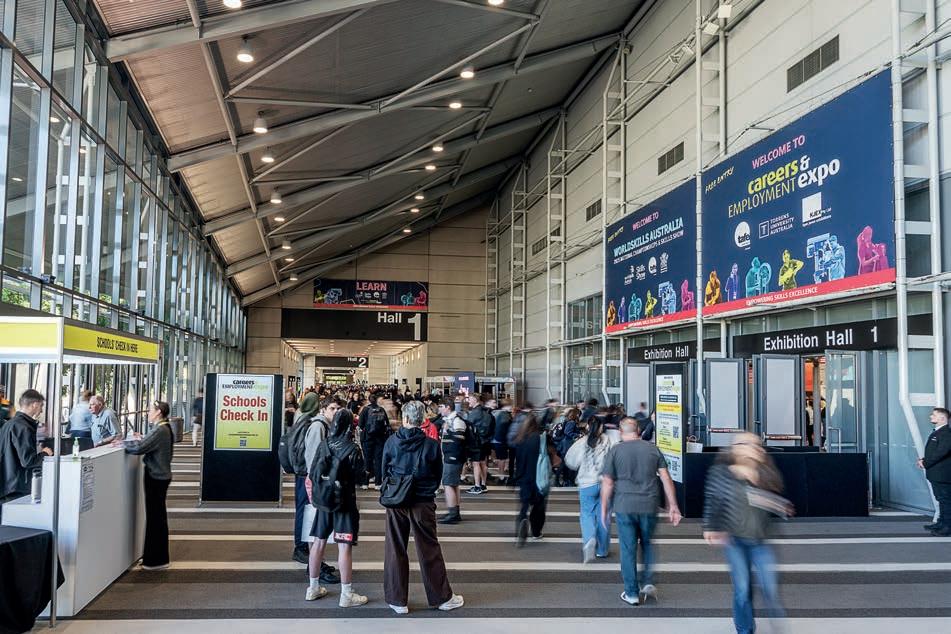
to represent Australia on the world stage. The Squad represents the very best of the nation’s skills sector, demonstrating not only technical expertise but also resilience, attitude, and a commitment to continuous growth. The official team will be announced in the coming months.
WorldSkills Australia is now preparing for the 48th WorldSkills Competition in Shanghai, China, in 2026, where the aforementioned Skillaroos will compete against the best in the world.
The organisation is inviting companies, training providers, and industry leaders to join them on this journey. Support in the form of funding, mentorship, and partnerships will be vital in helping the Skillaroos prepare for the global stage.
The event reflects a long-term commitment to raising the profile of trades & skills, empowering young Australians, and building a stronger, more capable workforce for the future. According to WorldSkills Australia, the success of the event was made possible through the contributions of partners, volunteers, training organisations, and educators from across the country.
By bringing together rising stars such as Nickl, the movement to celebrate the power of skills to transform lives and drive innovation can extend nationally and globally.
In the noisy digital world, brands on a mission to contribute to the coffee sector often struggle to solidify their voice. The Melbourne International Coffee Expo (MICE) enables new connections and bridges.
MICE is the playground for coffee lovers, nerds, experts and innovators.
In March 2025, the event brought together close to 32,000 attendees at the Melbourne Convention and Exhibition Centre to celebrate the growing industry.
MICE2025 provided a platform for 134 exhibitors eager to showcase their products, knowledge and solutions.
Following a successful event, demand to secure a spot for next year is increasing. Attracting café owners and experts in the food and beverage
brewing specialty coffees, backed by energetic music and lively conversations. The interactive elements extended to educational panels and talks from more than 50 speakers. Topics included coffee traceability, ethical sourcing and supply challenges.
The event also saw a rising interest in sustainability, particularly sustainable packaging in the food and beverage industry. Exhibitors
This conversation was part of a broader discussion that went beyond short-term fixes. By encouraging long-term thinking and critical conversations, businesses in the coffee industry can help safeguard the wider beverage sector.
One of this year’s exhibitors was Granded Packaging, a sustainable packaging solutions provider. The company’s regional manager APAC, Nathan Graham, was asked about the importance of sustainability. He addressed the current practices and standards set by the coffee industry.
importance of constructive dialogue in improving sustainability within the industry, noting that it catalyses innovation. He also said customers benefit from having clear, streamlined information to help them make informed decisions suited to their business.
‘Material agnostic’ was a term Graham used to describe Grounded Packaging. He advocated for food and beverage business owners to adopt this mindset, meaning that material selection should be approached with flexibility rather than focusing on a
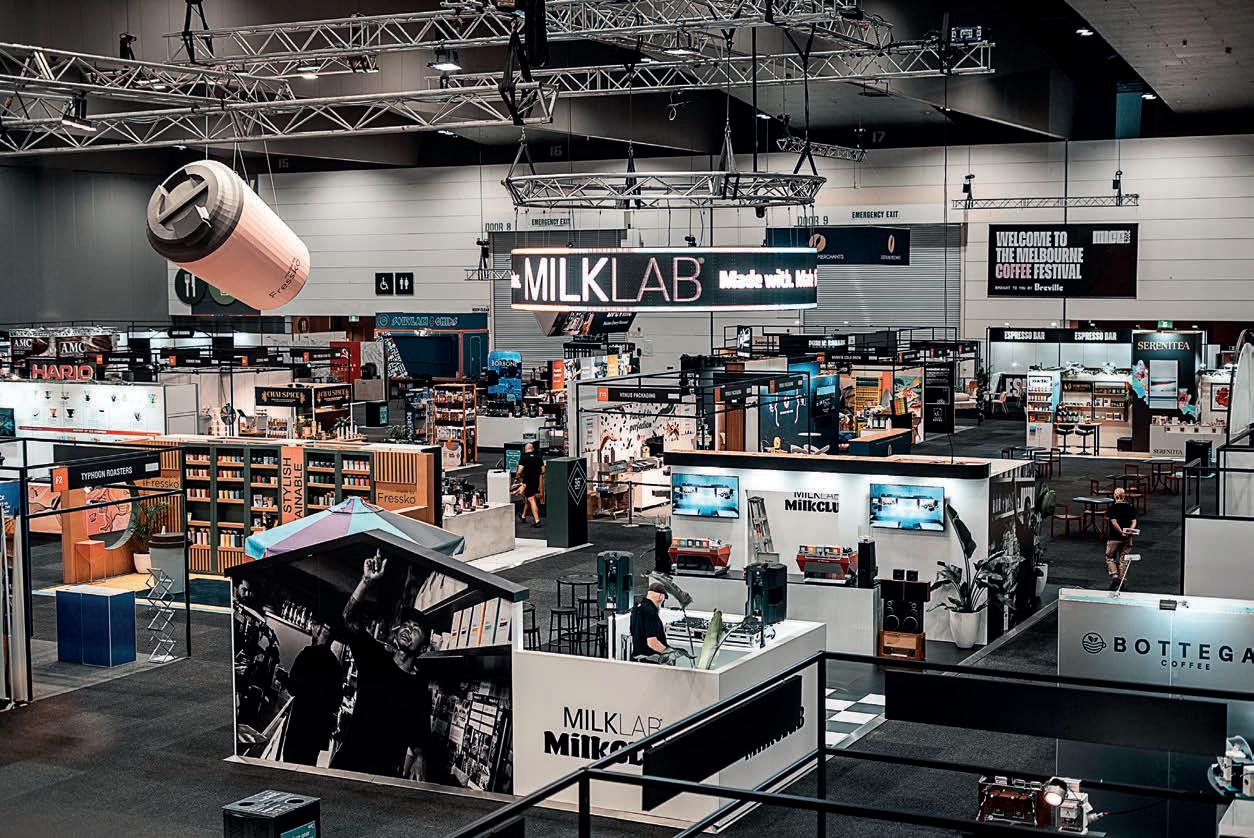

businesses risk compromising growth and profitability if they overlook tailored solutions. Just as each business has a unique selling point, they also need individualised approaches.
Expanding the options for sustainable tools and materials not only benefits the environment but also protects the industry’s diversity. Graham emphasised that promoting a single material type might simplify standards but fails to support the variety of businesses across the coffee sector.
Being material agnostic encourages meaningful conversations and the development of innovative ideas that serve a wider range of needs.
“It’s about helping people navigate to find the option that’s better for them,” said Graham.
MICE2025 enabled boundarypushing conversations around sustainability, reflecting the diverse range of coffee experts and solutions. These initiatives will return in 2026 to continue driving waste reduction and sustainable practices.
Providing a range of sustainable solutions, including packaging
manufacturers connected with café owners and industry leaders.
Graham shared how the expo brought the company closer to professionals in the sector – from brand owners to food scientists and engineers. He noted their positive responses and eagerness to understand Grounded Packaging’s offerings.
“It was really exciting as it helped show that what we are doing is really needed in the industry,” he said.
According to Graham, the expo made it easy to reconnect with existing customers while reaching
through the noise, bringing a brand’s message and values to the forefront.
Graham was pleased to present the company’s range of solutions, reinforcing its place in the coffee industry.
“The event allowed us to display that we are not just a packaging business but also a technology business,” he added.
“It demonstrated that the data and software tools available to us and our customers are invaluable in helping brands navigate the often complex and challenging landscape of sustainable packaging.”
“The coffee industry probably has a better grasp on sustainability and sustainable materials than most industries.”
new ones. One of the challenges businesses face is building real-life relationships with customers or reaching new audiences.
materials, supports not only the coffee industry but also food manufacturing as a whole.
Before MICE2025, Grounded Packaging had limited opportunity or time to engage with the industry. By gathering coffee professionals from across Australia, the expo helped foster new potential partnerships and contributed to the sector’s growth.
Another obstacle for brands is
Following strong responses from the industry and meaningful discussions around environmental responsibility, Graham confirmed his team would return in 2026. He praised the warm welcome they received from their peers and looked forward to another successful year.
“Everyone was just happy to be there,” said Graham. “They were very keen to chat and there was good camaraderie amongst the exhibitors.”
Organisers have confirmed that MICE2026 will be held at the Melbourne Convention and Exhibition Centre between 26 and 28 March. Stands are already being snapped up by those who attended the recordbreaking 2025 event.
Stands are open for booking via the official MICE website. F
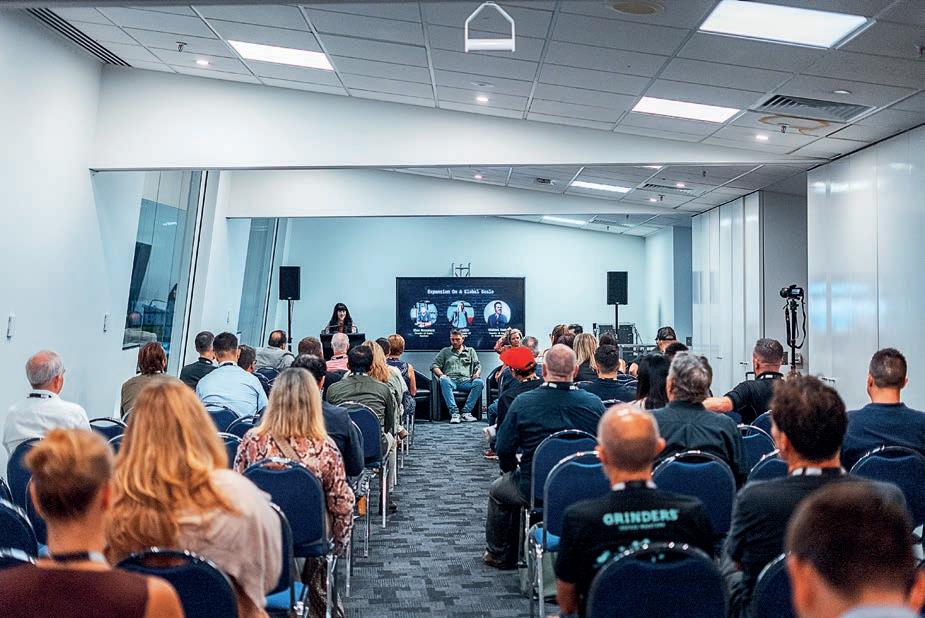

Food and Beverage Industry News talks to Dr Anthony Borneman from the AWRI as it looks to DNA-based testing to verify grapevine clonal identity.
Grapevine varieties underpin the entire wine industry.
While casual observers can often distinguish between types like Chardonnay or Shiraz, seasoned professionals rely on much finer distinctions, particularly at the clonal level. As Dr Anthony Borneman from the Australian Wine Research Institute (AWRI) explains, each variety originates from a single seed — a product of a reproduction event — and the plant grown from it is then propagated through cuttings. These cuttings are genetically identical to the parent vine, making each new plant effectively a twin. Over time, however, mutations creep in. These slight differences accumulate, giving rise to what
are known as clones. Each clone maintains the fundamental identity of the variety but may express subtle variations, which can influence everything from yield to disease resistance to wine characteristics. These mutations may not become apparent for several years after planting, adding to the complexity.
The global grapevine nursery industry relies heavily on clones. Growers choose specific clones when establishing vineyards, often based on desired wine styles, local environmental conditions, or disease resistance. However, Dr Borneman points out that the entire
system rests on a fragile foundation — paper records. Stick mislabelling, documentation errors, or loss of provenance information can result in a vineyard being planted with the wrong material.
In many cases, mistakes are never detected unless a significant difference becomes obvious, or someone with a trained eye happens to spot a visual discrepancy. Even in controlled environments such as nurseries or germplasm collections, undetected mix-ups can occur and persist indefinitely. Given the scale of operations — thousands or even millions of vine cuttings exchanged annually — the margin for error remains significant.
Until recently, genetic testing in viticulture had been focused primarily on identifying varieties. As Borneman notes, this type of testing has long been available and functions much like commercial ancestry testing for humans. However, the leap from variety identification to clonal identification has presented a far greater challenge.
Unlike varieties, which are as distinct as unrelated individuals, clones are more like twins. The differences between them are minute — often a single variation in a million DNA base pairs. Thanks to the long history of viticulture, particularly in old-world varieties, sufficient

time has passed for some clones to accumulate enough mutations to allow genetic differentiation.
The AWRI has now sequenced over 1,500 grapevine samples, representing a range of clones from various sources within Australia. This work, supported by Wine Australia and BioPlatforms Australia, has enabled the development of a robust reference database. According to Borneman, this database allows researchers to genetically match an unknown sample against known clones with a high degree of confidence.
“We do a full genome sequence on each sample,” he said. “Then we’ve got a bioinformatic back end that’s pretty sensitive to finding those onein-a-million differences.”
Years of refinement have gone into building a system capable of handling such a high level of genetic resolution. The result is a fingerprinting tool that can reliably identify a clone, or flag anomalies when a vine doesn’t match anything in the existing library.
The response from industry has already been encouraging, even before the formal launch of the commercial service. Growers, nurseries and vineyard owners have approached AWRI to verify plantings, particularly when documentation is missing or when blocks within a vineyard appear to differ unexpectedly. In some cases, new vineyard buyers have expressed an interest in using the service to check the identity of plantings that may be decades old.
Nurseries are also eager to adopt the technology to confirm the identity of their mother vines. For them, the service offers an opportunity to enhance quality assurance and maintain the integrity of germplasm collections. Given Australia’s strict quarantine and biosecurity protocols, preserving and verifying the genetic integrity of domestic material is especially important.
“People need to be sure they are getting what they think they’re getting,” Borneman said. “It’s a quality assurance thing.”
This is particularly relevant when vines are purchased for their specific clonal traits — such as
bunch architecture or the ability to produce a certain wine style. Buyers need to be certain that the planting material aligns with the stated clone, especially given the cost and longterm investment associated with establishing new vineyards.
The ambition is not only to verify identity but also to support the long-term sustainability of Australia’s viticultural base. With the ability to genetically confirm what is being propagated and planted, the Australian wine industry stands to benefit from greater accuracy,
traceability, and assurance.
Borneman sees a future in which this type of genetic check becomes a routine step in vineyard establishment and germplasm management.
He envisions growers using the information not only to identify mystery vines, but also as a tool before purchasing vineyards or investing in large-scale plantings. Already, cases have arisen where growers sought clarity about blocks with uncertain origins or suspected mismatches.
The groundwork laid over the past decade – from basic genomic research to the establishment of a national reference library – has positioned AWRI to launch a worldleading tool. In an industry where detail and origin matter profoundly, this DNA-based information marks a step forward.
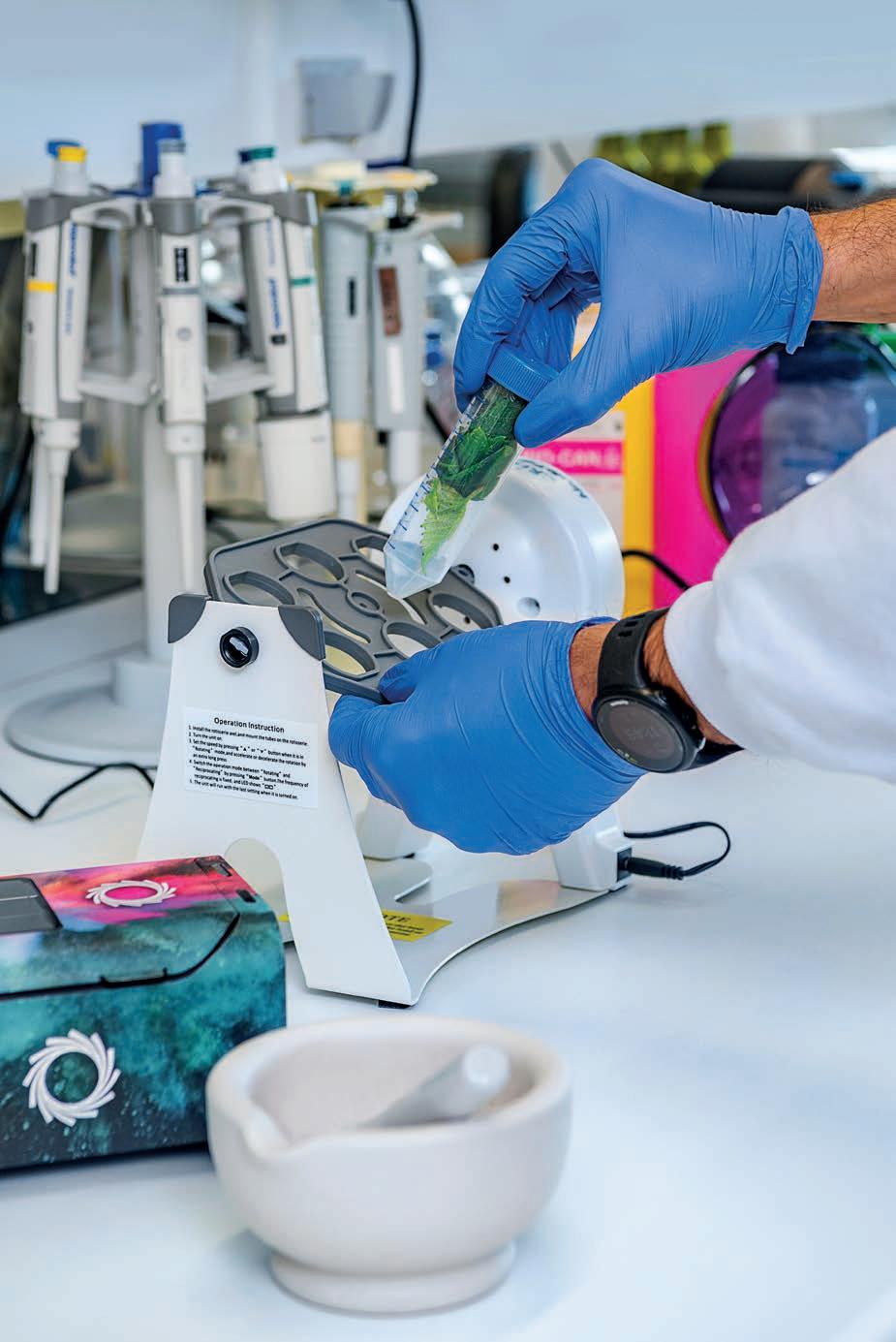
With scientific precision now j oining traditional knowledge, Australia’s vineyards may soon enjoy a new level of confidence in their most fundamental asset: the grapevine itself. F
Mars Food & Nutrition Australia and Foodbank Australia are expanding their partnership to make nutritious meals more accessible to communities in Australia.
In the last 12 months, 32 per cent – or 3.4 million – of Australian households have experienced food insecurity, according to the Foodbank Hunger Report 2024. In the current cost-of-living crisis, consistent access to nutritious food is not guaranteed for many Australians.
Food insecurity operates on a sliding scale. Some households are eating less nutritious food due to affordability, while others are regularly
“In Australia, the demand for supporting households facing food insecurity is growing,” said general manager, supply chain team at Foodbank Australia, Erica Goldfinch. “Furthermore, the demand for food, support and relief is at an all-time high.”
Goldfinch noted that traditional methods of seeking support, such as help from family and friends, are becoming less common. Increasingly, Australians are turning to food relief
and Foodbank Australia have taken a hands-on, long-term approach to improve food security through their Collaborative Supply Program (CSP).
Launched in 2021, the program has already donated 7.6 million meals. With the CSP rolling out again in 2025, the organisations are working toward an ambitious target of 12 million meals.
forecasting and manufacturing integration.
The foundation of this partnership is built on a shared sense of purpose. It is not about short-term gains or occasional contributions, but a long-term commitment to supporting vulnerable communities in sustainable ways.
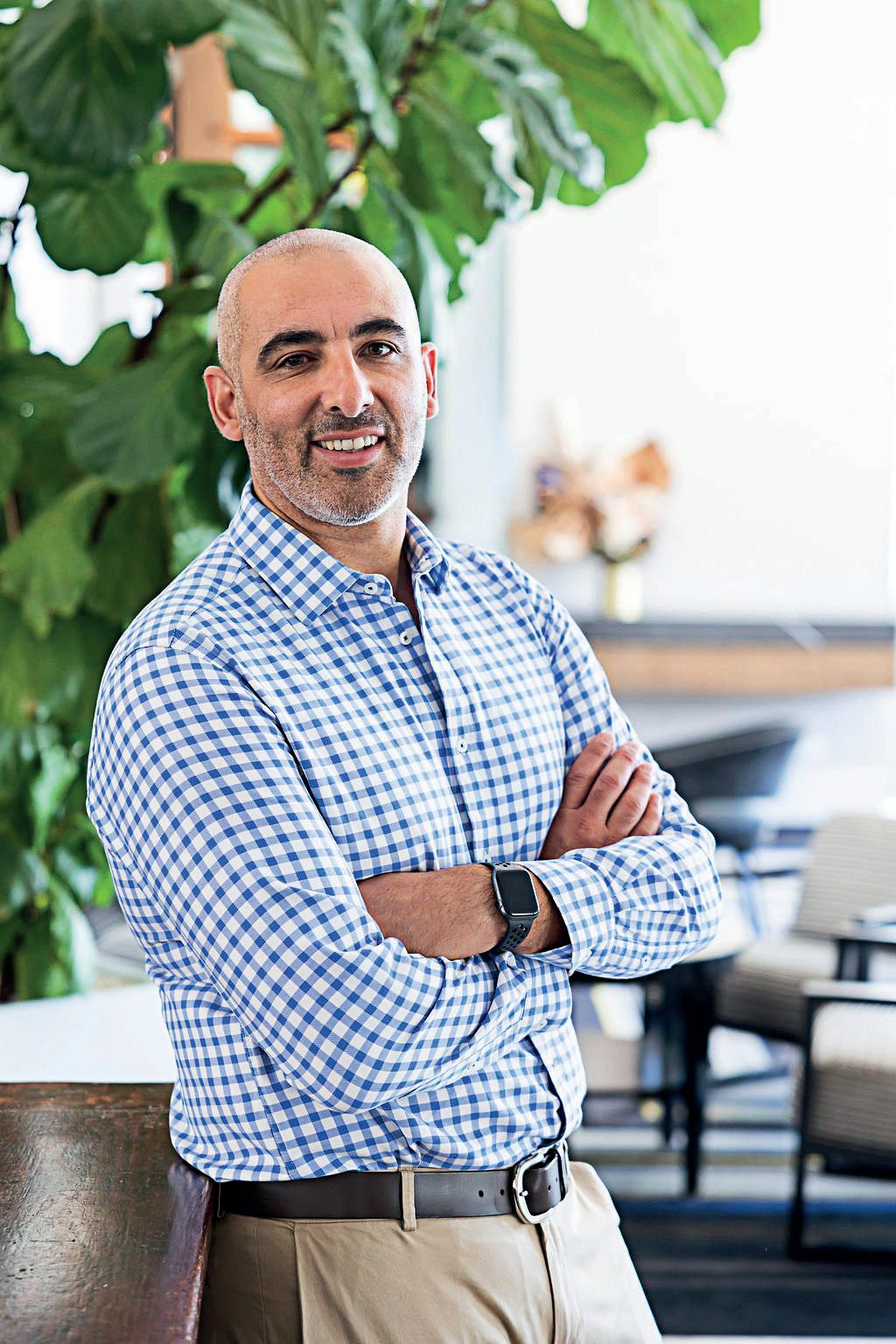
Recognising this urgent need, Mars
Through the supply of MFNA’s products, including Dolmio Extra Bolognese and Dolmio Creamy Carbonara sauces, individuals accessing Foodbank can combine these with fresh produce to create a complete meal. This year alone, MFNA will dispatch truckloads of food equal to 550 pallets of Dolmio pasta sauces and other MFNA products.
The two organisations have worked together for more than a decade. While the partnership began with traditional food donations, it has since evolved into a collaborative effort
MFNA’s supply chain director, Andrew Borg, credited Foodbank’s expertise with helping refine product offerings and processes over time. He said the partnership has allowed MFNA to play a meaningful role in tackling food insecurity in Australia.
“MFNA is a principle and purposeled business, and we understood that there’s more we should be able to do in this space,” he said.
He recalled the pandemic as the height of food relief and food insecurity. After the realisation that the current process taking place was below par, MFNA spoke to Foodbank to see what could be improved. Through Foodbank’s expertise, connections and proximity to the
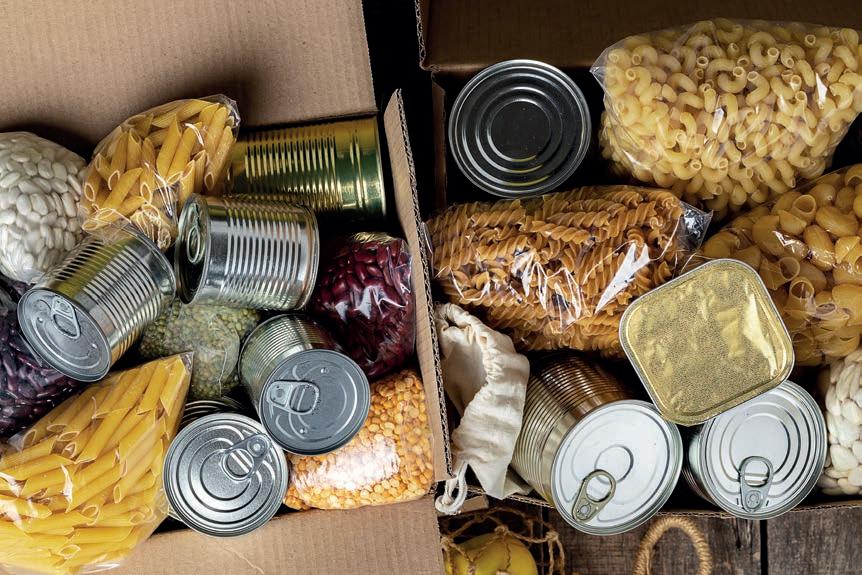

capacity with trends in demand for staple products. This includes planning regular donations of highdemand items such as pasta sauces and rice, ensuring food relief services across the country have a steady, reliable supply.
Goldfinch also praised MFNA’s efforts to reduce its carbon footprint by managing storage and stock movements more efficiently, helping deliver food more sustainably nationwide.
“Every year, the partnership grows with the support of MFNA and all the partners that contribute to feeding more Australians,” she said.
resilient in the face of rising need Borg admitted his concerns for the problems surrounding food insecurity.
“The food insecurity challenges in Australia are unfortunately not going away,” he said. “As Australians, we should all be concerned about making food accessible to everybody.”
He believes food businesses must play an active role in addressing the issue. By kickstarting initiatives and building long-term programs, the industry can set an example
for others to follow. He added that collaborations and partnerships are essential to achieving progress in the sector.
Looking to the future, both Foodbank and MFNA are committed to deepening their collaboration. They are exploring new ways to reduce inefficiencies, streamline logistics and scale their model to reach more communities across Australia.
to source 250,000 meals per day, the equivalent of 92 million meals or 51 million kilograms of food annually.
She emphasised that partnerships like the one with MFNA are essential to achieving that goal.
“These programs would not have
We look forward to another fabulous CSP rolling out this year to feed more Australians.”
As demand for food relief continues to grow, long-standing partnerships like this will only become more critical. The collaboration between MFNA and Foodbank is a model of what can be achieved through trust, transparency and shared purpose and how working together can make a lasting impact on communities in need. F
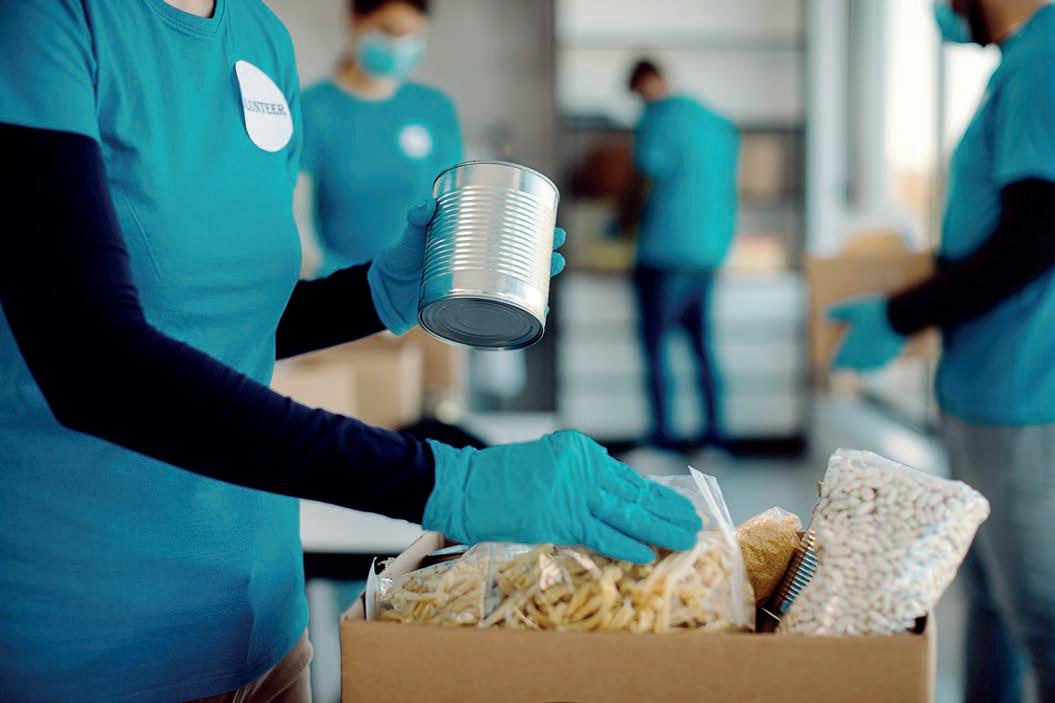
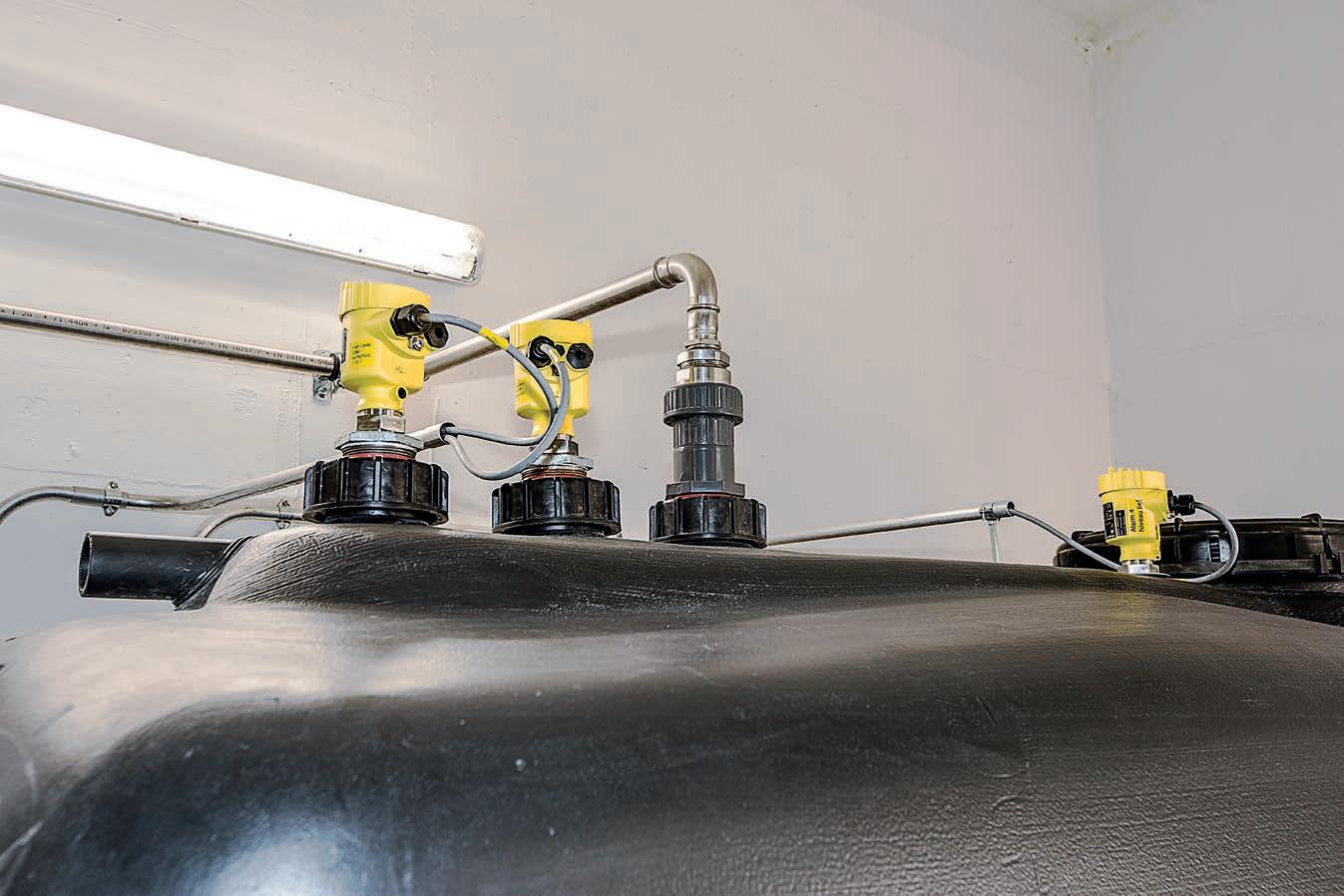
managing inventory, and ensuring smooth production. From one of the world’s largest grain mills in Switzerland to a traditional family brewery in Germany’s Black Forest, the need for accurate process control is being met by specialised sensors developed for the most demanding environments. These sensors from VEGA, including the VEGAPULS and VEGACAP ranges, are helping manufacturers modernise operations while preserving core product integrity. At Swissmill, based on the Limmat river in Zurich, around 1,000 tonnes of grain are processed daily. This output supplies flours, semolina and flakes to commercial bakeries, pasta producers, and starch factories across the region. The scale of the operation, combined with the complexity of the production processes, makes transparency and
plant’s level sensors, which provide the real-time data required to keep operations running efficiently.
As part of Swissmill’s continuous improvement approach, production has been streamlined by removing one processing step common to many other mills. This reduction helps save energy, a key objective of the business. However, fewer steps mean fewer buffer points, and increasing the need for precise and dependable monitoring of all product flows. The measurement of levels within silos and other storage units is fundamental to this system, especially given the highly variable nature of the materials involved.
Measuring flour levels accurately presents specific challenges. The filling process generates significant amounts of dust, which takes time to settle and can interfere with
during summer months has a very low Epsilon value. This product is stored in slender, 10-metre-high reinforced concrete silos, adding physical complexity to the measurement task. Over the years, various level sensors were trialled at Swissmill. Guided microwave sensors were once used but had limitations. Their cables occasionally became unravelled, causing particles to become trapped and generate false readings. These have since been replaced by the VEGAPULS 69 radar sensor, which operates at 80 GHz. This high-frequency radar technology enables non-contact measurement, unaffected by heavy dust clouds. The VEGAPULS 69 is particularly effective for bulk solids in difficult environments and ensures consistent, reliable level detection in even the most problematic silos.
These sensors offer simple, robust point level detection, particularly useful for ensuring grain delivery and storage operations function without interruption. The VEGACAP 63 instruments are also deployed in animal feed production. During the pelletising process, the predepot must remain filled to maintain correct pellet density. Accurate level readings from the overflow cell determine whether additional storage cells are opened or kept closed. An overflow triggers a shutdown of the dosing system, and if not resolved quickly, can halt milling altogether. This makes the reliability of level measurement a key factor in avoiding costly disruptions.
Beyond internal operations, Swissmill also provides inventory management for external partners. In total, the company oversees

approximately 200 silo cells within its own premises, and an additional 150 silos that belong to customers. Level measurement data from VEGA sensors is integrated with the VEGA Inventory System, a web-based software tool for acquiring and visualising level data in silos and tanks. This allows Swissmill to remotely monitor stock levels at customer sites and, when necessary, order additional supplies on their behalf. In effect, many customers entrust their raw material logistics to Swissmill, improving supply chain efficiency through enhanced visibility and coordination.
A similar commitment to precision and process control can be found at the Ketterer family brewery in Hornberg, Germany. Operating in a competitive sector, the brewery has focused on combining traditional brewing methods with advanced technology to ensure product consistency and reduce resource consumption. Investments in modern equipment, including VEGA sensors, have helped the
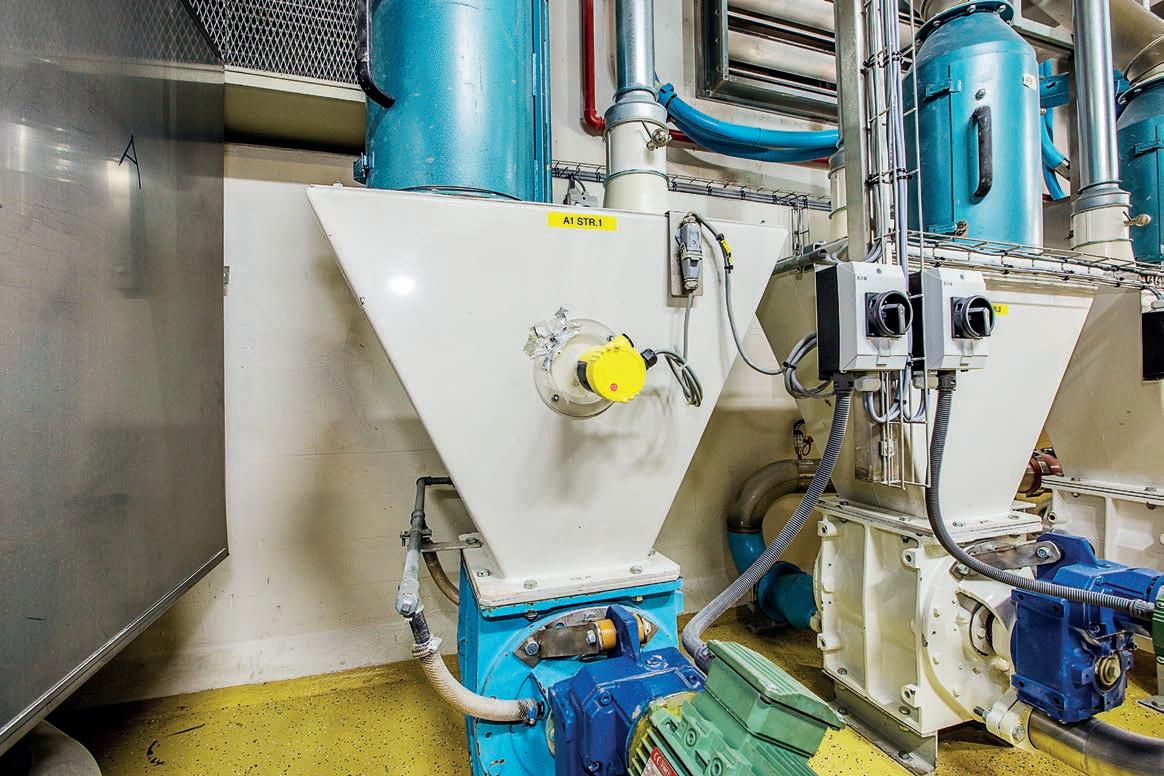

business remain efficient without compromising its heritage.
VEGA technology has been part of the brewery’s setup for more than 20 years. It began with the installation of a level system on a spent grain silo and gradually expanded across the facility. Many of the improvements to the plant have been driven by rising hygiene standards, which required the fermentation and storage tanks to be redesigned for easier cleaning. Today, VEGA sensors play an integral role throughout the brewhouse, from CIP systems and brewing water tanks to the fermentation and storage vessels. These sensors provide overfill protection, manage inventory, regulate dosing during mixing, and support overall process control.
One widely used sensor within the brewery is the VEGAPULS 63, a non-contact radar level transmitter designed for hygienic applications. It has been used extensively on the large maturation vessels that store different beer varieties. These tanks
An overflow triggers a shutdown of the dosing system, and if not resolved quickly, can halt milling altogether. This makes the reliability of level measurement a key factor in avoiding costly disruptions.
have complex internal structures, such as spray cleaning heads and sloped bottoms, along with mixing lines for products like shandy.
The VEGAPULS 63 could manage these complexities, however, when excessive foaming from mixed drinks began affecting measurement accuracy, an upgrade was needed. To solve this, the brewery adopted the VEGAPULS 64, another radar level sensor operating at 80 GHz. With its narrower beam and improved focusing, it delivers more accurate readings, even through foam, and achieves a measurement precision of +/- 2 millimetres. This upgrade brought a boost in measurement reliability and consistency, which is
crucial given the brewery’s exposure to varied cleaning procedures, including cold water rinses and occasional steam treatments. Robustness and hygienic process fittings are essential for all equipment used on site, and the VEGA sensors meet these demands well.
In the most recent plant expansion, a buffer tank was installed to store mineral water. Here too, a VEGAPULS 64 was chosen to manage inventory. The water used in brewing is a major factor in determining the final product’s taste and quality. Ketterer has long placed special emphasis on sourcing high-quality water and years ago discovered a soft-water spring in a forest tunnel above Hornberg.

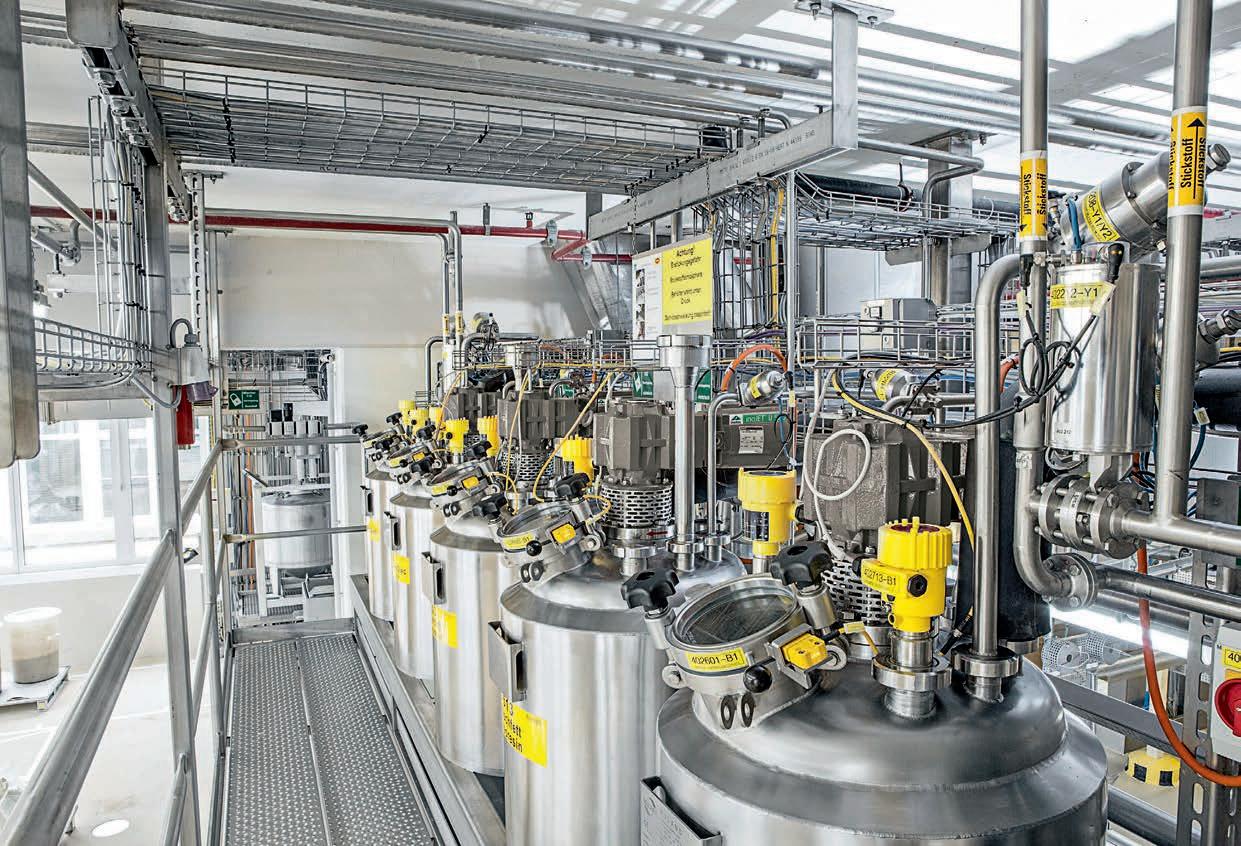

The water from this spring was so exceptional that the brewery began bottling it as a stand-alone product, now sold under its own brand name across Germany. This line has since become an important part of the business, adding a second revenue stream alongside beer production.
The experiences of both Swissmill and the Ketterer brewery illustrate how tailored level measurement solutions can support operational excellence in different contexts. Whether managing thousands of tonnes of grain in a high-volume urban facility, or producing smallbatch beverages with artisanal care, the need for dependable, accurate, and robust measurement systems remains the same. Instruments such as the VEGAPULS 63, VEGAPULS 64, VEGAPULS 69, and VEGACAP 63 are proving indispensable in helping manufacturers meet production goals, ensure product quality, and maintain inventory visibility, hallmarks of resilient, future-ready operations. F
















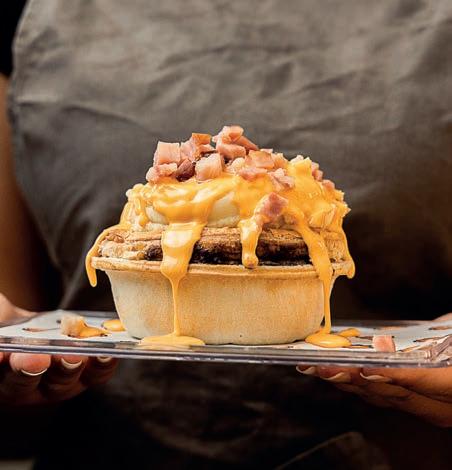


To accomplish its mission, a food charity organisation got creative with its warehousing and logistics to reduce food waste and satisfy struggling Australians.
The saying ‘killing two birds with one stone’ is embodied by food charity organisation SecondBite. The organisation’s goal is simple – rescuing quality food from going to waste and feeding hungry Australians who are struggling every day.
While the organisation cares deeply about the sustainability of the planet, it also takes direct action to be a responsible organisation through efficient processes that contribute to this cause.
In 2005, when founders Ian and Simone Carson saw a surplus of quality food and produce being thrown out at their local market in Prahan, Melbourne, the story of SecondBite began. Starting small, they gathered friends and family to collect unsold food in their cars and deliver it to a local food charity.
What started with delivering 600 kilograms of food – equivalent to 1,200 meals – has grown to reach more than 350 million meals across Australia. Collecting close to 69,000 kilograms of food per day, SecondBite delivers food to all corners of Australia supporting communities in need.
Going a long way with help from friends
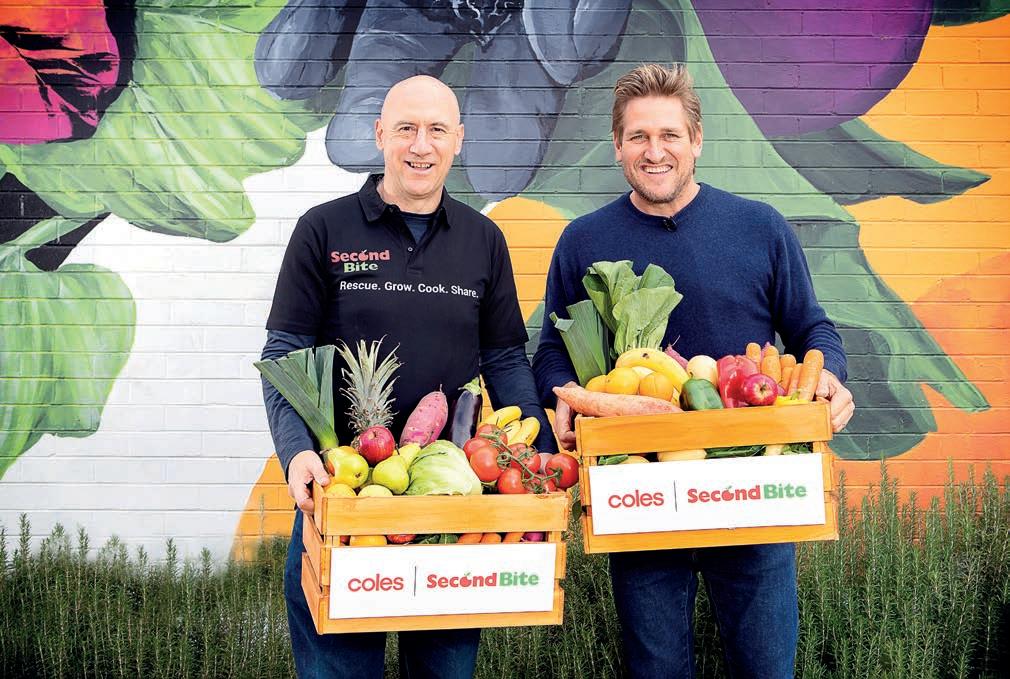
the times people struggle with food insecurity,” said head of sustainability at SecondBite, Eliza Hobba.
Michelin-trained chef Sergio Perera was also appointed as a new ambassador for SecondBite.
With a shared goal of fighting food insecurity across Australia, Coles has partnered with SecondBite since 2011.
SecondBite and its network of more than 1000 charity partners collect unsold, edible food from more than 840 Coles supermarkets.
The rescued food is then distributed by the charities to people in need of food relief.
Together, Coles and SecondBite have provided the equivalent of more than 290 million meals to Australians doing it tough. Every year, Coles and SecondBite run the Winter Appeal to support Australians in need.
“It’s a beautiful campaign because when we think about winter, they are
During the campaign, Coles’ customers contributed by purchasing $2 SecondBite donation cards or donating at the checkout. All funds raised went directly to SecondBite to boost operations and increase capacity to deliver more food to Australians in need during the winter months.
This year’s campaign featured brands including Chobani, Gippsland Dairy and Mount Franklin, each donating 20 cents per participating product sold at Coles, both in-store and online.
Hobba expressed her excitement about the involvement of well-known chefs in this year’s campaign.
“We’ve got Curtis Stone who’s wandering around our kitchens this week,” said Hobba.
While the organisation has expanded its efforts to carry out its mission more efficiently through campaigns that increase operational reach, there are still ongoing challenges affecting overall food security.
According to Hobba, climate change adds a new layer of difficulty to addressing food insecurity and poses distribution challenges. To tackle these issues, she explained how SecondBite is improving its warehousing and logistics in collaboration with local communities.
SecondBite’s logistics and infrastructure are structured around geographic locations – a factor that influences food insecurity.
With warehouses in Victoria, New South Wales, Queensland, South Australia and Western Australia, the organisation also operates a fleet of more than 40 trucks of varying sizes up with capacities up to 13 tonnes carrying capacity and room for 14 pallets of food. Working closely with regional agency partners, SecondBite monitors operational costs, collects donated food from donors, and coordinates meal production.
Taking into account driving time and distance travelled, Hobba described SecondBite’s role in delivery logistics.
“We have a sort of hub and spokes model to get rescued food out to further communities in regional and remote Australia,” said Hobba.
She said strategic routes are planned between supermarkets and warehouses to ensure food is collected within strict timeframes.
Given the shelf life of perishable items, these measures are essential to ensure time for processing and distribution.
Distribution centres typically handle larger bulk deliveries with palletised food, whereas supermarket pickups involve smaller volumes. Once food arrives at the warehouse, it is sorted into delivery groups for dispatch the following day.
With stricter regulations around food safety, all time-sensitive foods that SecondBite collects, stores and delivers are kept in temperaturecontrolled conditions.
Hobba explained that all delivery trucks are refrigerated, particularly for high-value items such as fresh produce and meat. Whether through portable eskies or in-built cold storage, SecondBite is continually seeking new ways to maintain food quality for recipients. Additionally, all of SecondBite’s warehouses across the country are refrigerated.
Outside of temperature control, the organisation also pays close attention to food packaging. With
of meals. This includes Cryovac and shelf stable packaging that removes oxygen or uses heat to preserve food for up to two years.
“Australia is a big country, and our food travels such long distances,” she said. “How we package the food and how we transport it with minimal amount of food loss is always our priority.”
As Hobba listed innovative solutions to address warehousing and logistics challenges, she emphasised the strong support SecondBite receives from local industry partners. One
significant threat some warehouses face is flooding. During a recent flood event in Queensland, the SecondBite team faced many challenges.
Thanks to a network of trusted local partners and logistics contacts, the organisation was able to act quickly.
One logistics partner, Lineage, cleared SecondBite’s warehouse and stored all its meals in refrigerated space before the floodwaters arrived.
“It takes a village to run this organisation,” said Hobba.
While some challenges remain beyond anyone’s control, the shared commitment to reducing food waste and feeding hungry Australians brought different sectors together to solve problems in real time.
Hobba concluded by acknowledging other charity organisations contributing to the same cause. While each has its own approach, she recognised the strength in diverse operations working towards the same national goal. She emphasised that food insecurity is not something one organisation or industry can solve alone – but it is a problem that can be managed through collective effort and smart logistics.
“I won’t say it’s a solution to food insecurity because it’s not,” she said. “But it’s realising the effort that’s gone into growing our food to make sure that it gets to where it needs to go, which is people’s mouths.” F

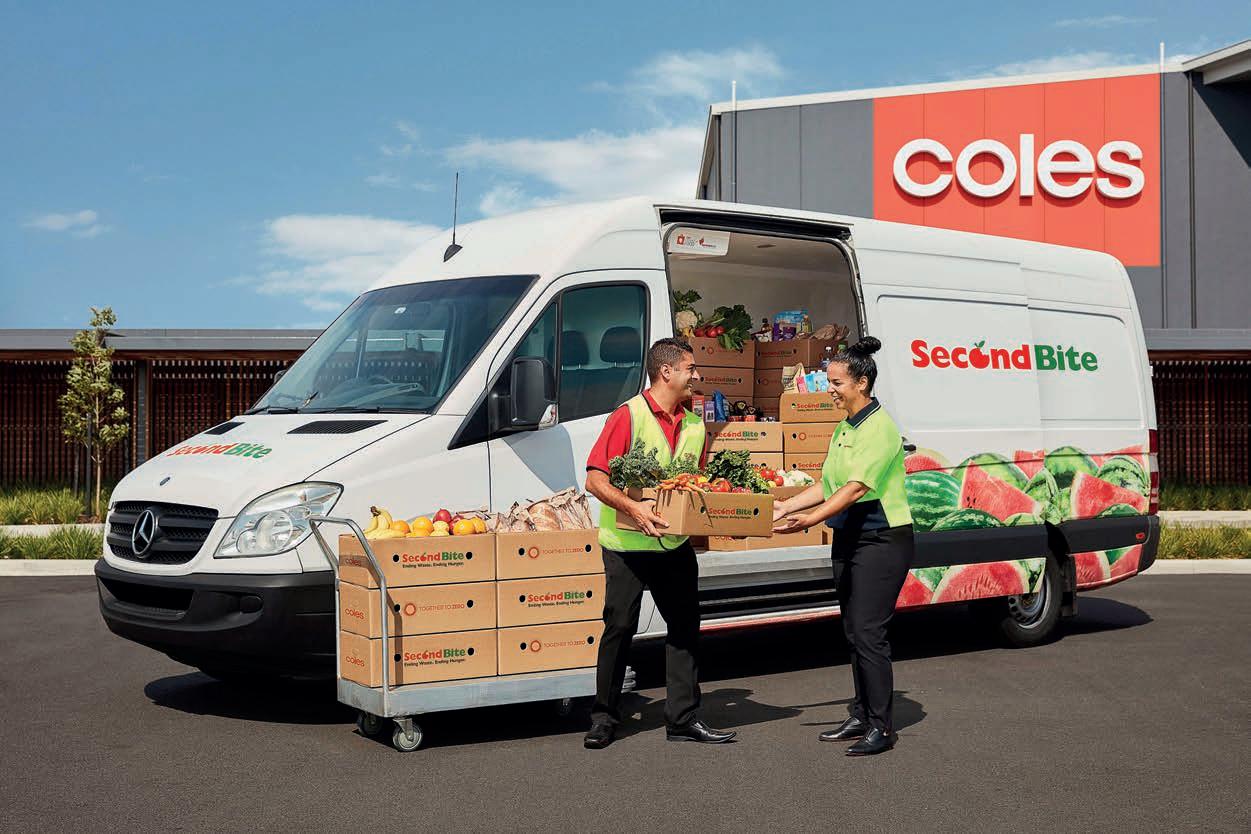
Australian companies continue to innovate in the recyclable packaging space as showcased at the PIDA awards.
Author Nerida Kelton FAIP, Executive Director AIP – Vice President Sustainability & Save Food – WPO
Box-Bottom paper bags and mono material retort pouches took centre stage at the recent edition of the Australasian Packaging Innovation & Design (PIDA) Awards with both innovative packaging designs taking out multiple awards.
Australasian first box-bottom paper bag
Macro Health Food Box-Bottom Paper Bags, from Woolworths Food Co, were recognised with two gold awards in the food and sustainable categories.
Macro, a Woolworths brand offering high-quality foods, is committed to sustainable packaging solutions that align with consumer expectations for reduced plastic and recyclability.
Its innovative response is the introduction of a flat box-bottom stand-up paper bag for dried fruits and nuts, which is a first in the Australian market.
Macro’s shift to paper-based packaging delivers benefits for both consumers and the environment including replacing existing soft plastic packaging with a kerbside recyclable paper-based alternative, incorporating advanced barrier technology for product freshness.
Kerbside recyclability of the box-bottom paper bags allows for easy disposal at home. Consumers can place the pack in their kerbside recycling bin without needing to make a special trip to a drop-off point.
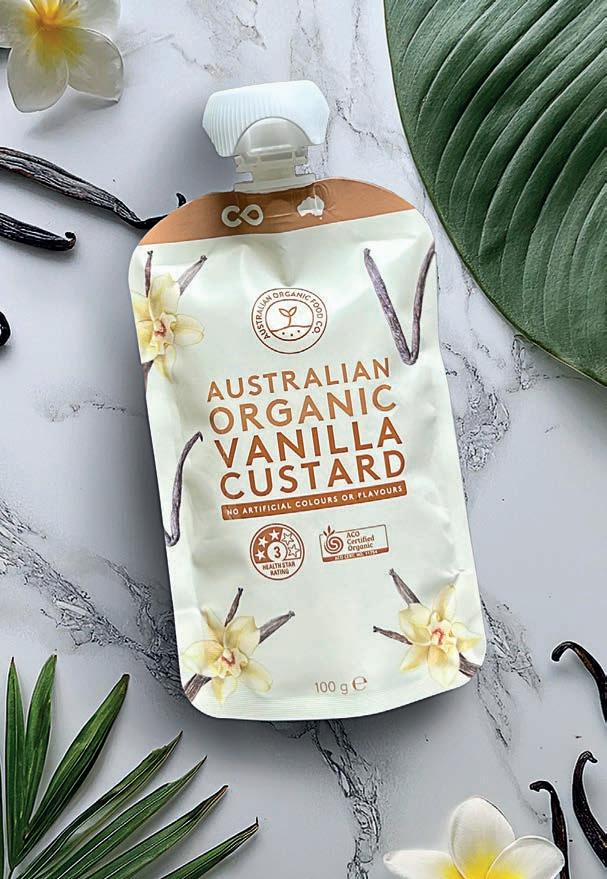
barrier technology ensuring product freshness and protection, without compromising on quality.
The flat box-bottom stand-up bag format optimises shelf presentation and transport efficiency. This efficient design helps to reduce waste and transportation costs.
The transition to paper results in an 86 per cent reduction in plastic usage, saving 96 tonnes of plastic annually across 12 million packs.
By prioritising both functionality and environmental responsibility, Macro are setting a positive example for industry.
Australian Organic Food Co. was also recognised with a gold in the Sustainable category and a silver in the food category for their Vanilla Custard Mono Material Retort Pouch. This world-first packaging was in partnership with Flavour Makers + Cheer Pack Asia Pacific.
The Australian Organic Food Co. Vanilla Custard is a single-serve, on-the-go snack made with certified organic ingredients. Due to the retort cooking process, the custard inside is commercially sterile, while the high-barrier packaging ensures sterility throughout its shelf life. This approach means the custard requires no refrigeration, making it suitable for lunch boxes, desk drawers, or vending machines, and for distribution through ambient supply chains.
The new mono material retort pouch is a recyclable mono-material pouch that maintains a low oxygen transmission rate after retorting and offers sufficient durability to withstand the rigours of the supply chain.
By inserting a spout into the new pouches created a new set of technical challenges to overcome as bonding soft plastics to rigid plastic components at high speed has typically required temperatures too
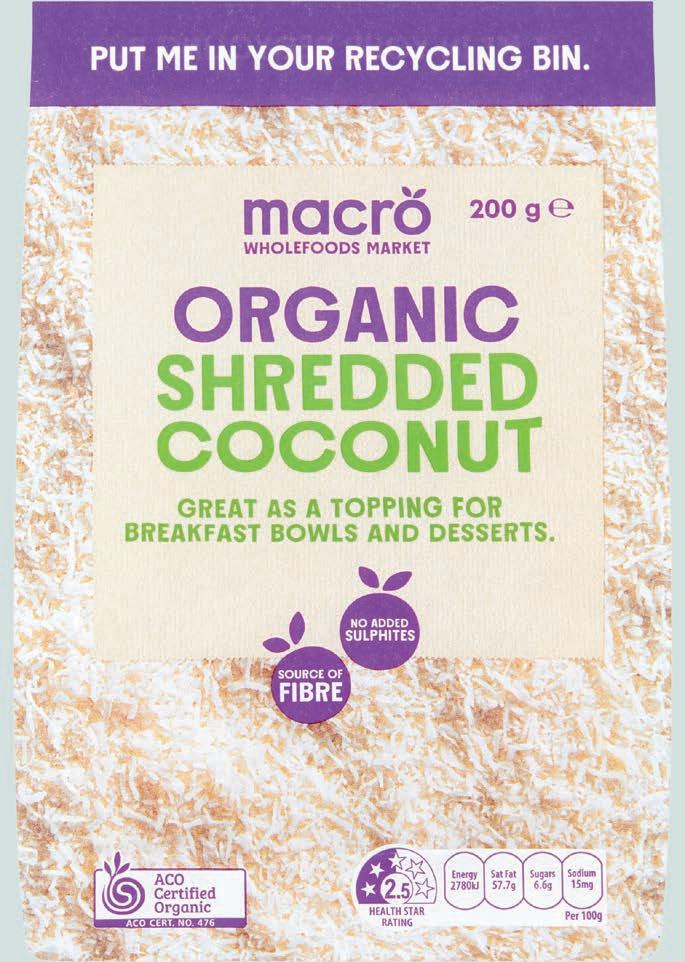
high for mono material structures, often leading to material shrinkage or damage to the barrier layer. This was overcome with the new design.
To further enhance the design, the new cap shape uses 20 per cent less plastic compared to the previous version without compromising functionality or accessibility. This improvement underscores a commitment to material reduction. While the finished product may look like a typical spout pouch to consumers, it represents a leap forward in mono-material innovation. This achievement was made possible through the creation of two specialised state-of-the-art films and an augmented converting process developed specifically for this application. That is why the pack is the first of its kind to be launched, world-wide.
What makes Woolworths and Australian Organic Food. Co. stand out is that they were willing to undertake the research and development to design innovative and unique packaging that not only offers a lower environmental impact but also sets them apart from their competitors.
The Australasian Packaging Innovation & Design (PIDA) awards are the entry point for Australia and New Zealand into the prestigious WorldStar Packaging awards; with Macro and Australian Food Co. now eligible to enter the next round which will be open later in 2025. Both packs are new to the categories they serve and are a testament to how innovative the packaging technologists are in the Australasian Region. F
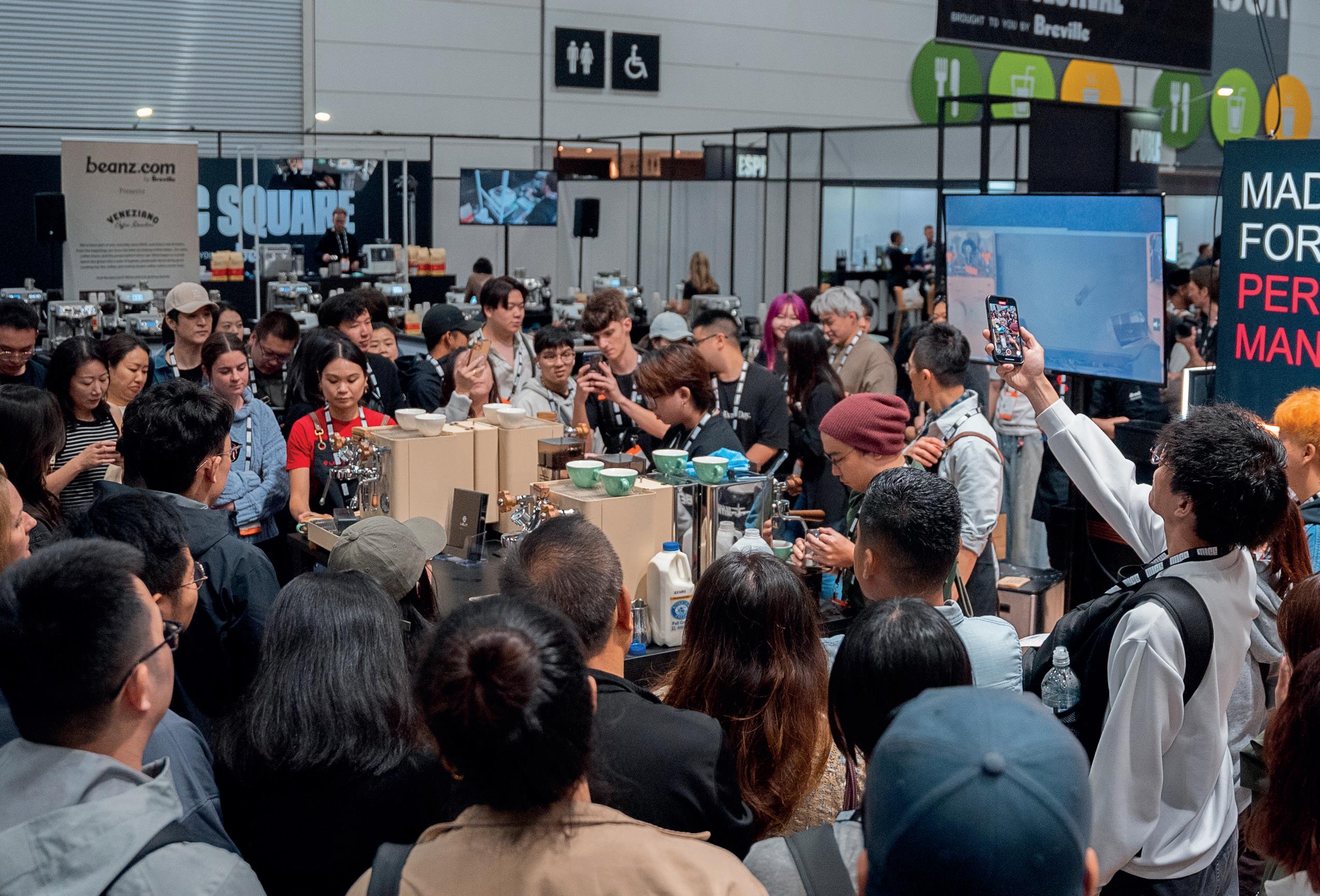



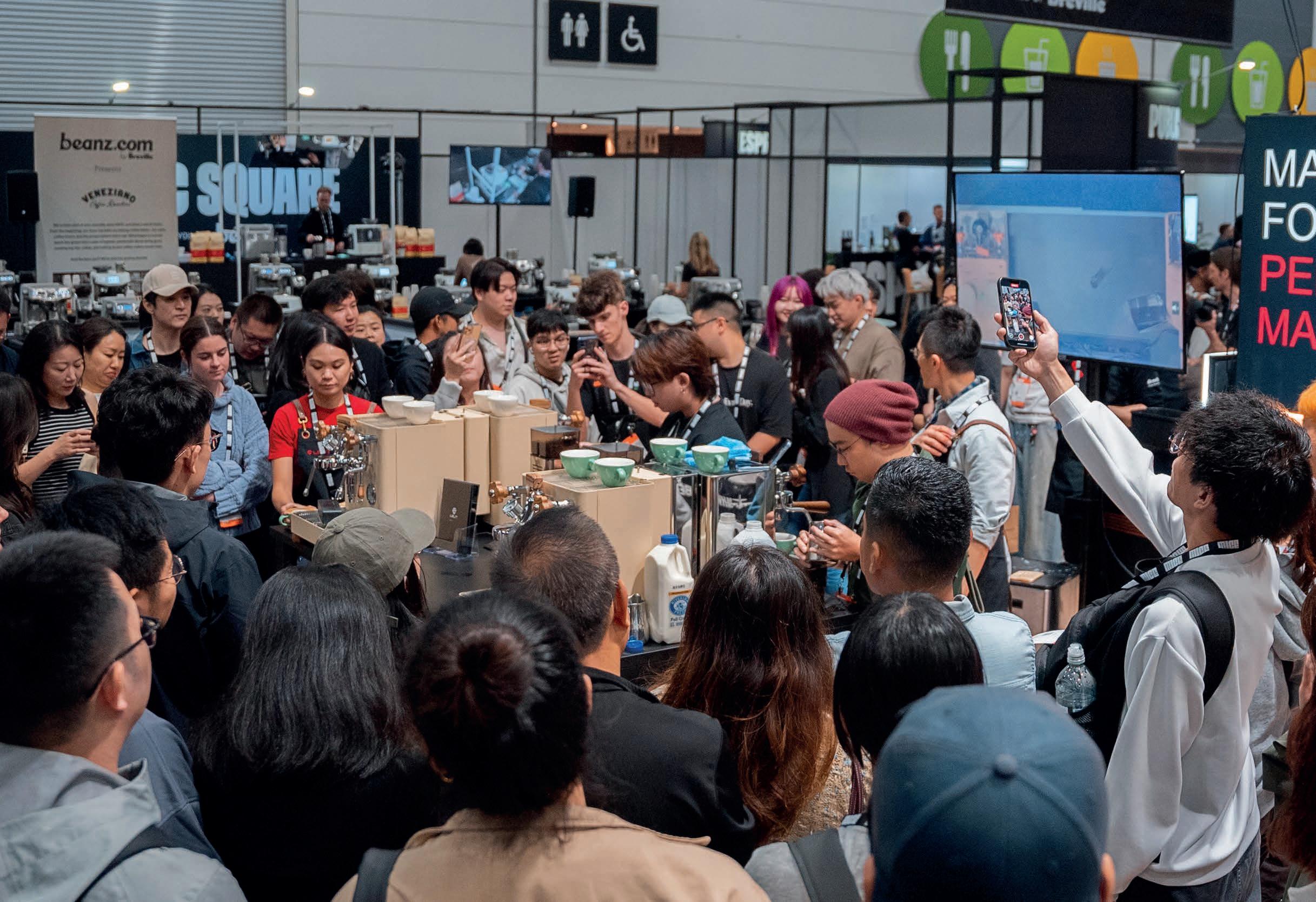
Become a part of the world’s destination for coffee at MICE 2026. Don’t miss out on the opportunity to contribute to the southern hemisphere’s leading coffee event.
Melbourne Convention and Exhibition Centre 26–28 MARCH 2026
Without the help of expensive equipment or time consuming processes, researchers have developed plant-based cheese that mimics real cheese.
Plant-based food technology isn’t new – it’s something that calls for extra attention, detail and study. With increasing demand for healthier food options, research to produce meat and dairy alternatives is more prominent than ever.
Take cheese. Imitating its appearance such as the colour, smell, and taste is important, yet elementary. There are also other characteristics it needs to have. Does it stretch? Does it melt? Is it as nutritious? Does it turn a nice golden brown under the grill?
Researchers from University of New South Wales (UNSW) found a solution to all these questions in their recent breakthrough in plant-based cheese.
When PhD student Canice Yiu began his thesis under Professor Cordelia Selomulya and senior lecturer Dr Yong Wang at UNSW, the team identified challenges in plantbased cheese from the consumer’s perspective.

“The idea came from looking at what’s currently on offer in the market,” said Selomulya. “There’s plant-based cheese in the market that looks like
cheese and tastes like cheese, but they don’t behave like cheese.”
“Giving an option for people to choose is actually more important than creating something that replaces it,” said Yiu. “People need a reason to choose an alternative that has similar characteristics to the real thing.”
By developing cheese made from plant proteins that mimic the sensory properties of traditional cheese –from texture to nutrition – the food engineering team aims to tackle food insecurity and environmental pressures.




The research began with Yiu’s observation of a Japanese rice cake, mochi. Observing its stretchy properties, he used it as a base to drive the research. As plant-based proteins differ from animal proteins and their properties, the challenge was finding ways to imitate animal products.
“A major part of it is nailing the texture and the experience of eating the traditional counterpart,” said Yiu.
Tissue engineering is a scientific process used in medical research to grow structures that imitate





explained how they did not apply it directly in their research – although they were inspired by the principle.
“When you look at how people grow tissue in the lab, they grow it layer by layer,” she said. “We use the same principle, but instead of growing cells, we assemble polysaccharide and protein.”
The structures are built layer by layer using pea protein and polysaccharides – large carbohydrates found in food. Using the team’s unique gelation approach, they were able to replicate the stretch found in real dairy cheese.
While stretchiness is a key textural feature, Yiu said the team first had to understand the melting properties of cheese. Using commercial plantbased cheese products sold in supermarkets, the team assessed their melting behaviour visually by heating them in ovens.
“It was important for us to first tackle the meltiness to see if we could incorporate the formulation to give us the stretchiness too,” Yiu said. By studying the composition of commercial plant-based cheese, the team improved its own formulation to develop both melt and stretch
alternatives that blend plant proteins with complex carbohydrates.
“The key is understanding how the formulation works and also how you treat those formulations so that it can create that behaviour like stretchiness,” said Selomulya.
While achieving the physical properties of cheese improves the culinary experience, the question remains whether plant-based foods provide as much nutritional value as their animal-based counterparts. As consumers become more informed, they’re making better choices based on nutritional content.
Recently returning from the Future Foods Congress in Singapore, Selomulya noted how great expectations for plant-based products – predicted to grow from a consumer science perspective – had plateaued. While high processing costs contributed to the underperformance of plant-based foods, she said consumer awareness of nutrition was the most critical challenge.
“The consumer now is much more
have enough nutritional value, they question why they should pay more for that product.”
According to Yiu, commercial plant-based cheese products typically focus only on replicating the flavour of real cheese. While analysing these products, he noted a lack of protein compared to animalbased cheese.
“The most important aspect of eating cheese is just lost there,” he said. “Cheese is a high-protein food, and not having enough protein basically defeats the purpose of eating cheese.”
He added that replicating the properties of animal proteins using plant proteins while retaining the physical traits of cheese is a challenge.
“There are a lot of properties that are only available with animal-based ingredients,” he said. “Plant origin of these proteins makes it harder to manipulate them to form the properties we expect. That is why we try to leverage more different types of ingredients to mimic the properties of these proteins.”
Nutrients are often lost at high temperatures. Yiu’s research focused
only mild gelation temperatures. Another way they improved the nutritional profile was by incorporating nutrients into different phases of the gels and structures.
“We can encapsulate nutrients in this emulsion or gel because the process itself is done at very mild temperatures compared to extrusion, which is another method used for plant-based foods,” said Selomulya. Their process differs from conventional methods. For example, coconut oil is commonly used in commercial plant-based cheese due to its melting point. While helpful for texture, it is a highly saturated fat often considered unhealthy. Due to his precise methods, Yiu’s formulation allows the use of less saturated fat by encapsulating it – a key differentiator from many commercial plant-based products.
When asked about the practicality of developing UNSW plant-based cheese, Selomulya said the production process was simple.
“It’s very scalable and the reason for that is because you don’t need

new or specialised equipment,” she said.
Researchers often face challenges when trying to scale up a product due to expensive or complex processes. Even with promising outcomes, industries may struggle with implementation.
“We already talked to some potential industry partners and how they produce their products at a larger scale,” she said. “Essentially, they could make this product with whatever equipment they had.”
Selomulya also highlighted a broader issue in Australia’s plant-based industry, recalling a conversation with an Australian plant-based cheese producer. While the products were sold in major supermarkets like Coles and Woolworths, the manufacturing was done overseas – mostly in Europe, where producers saw long-term value in the sector.
“That’s a missed opportunity for us,” she said. “When you are blessed with abundance, you’re not as desperate compared to countries like Singapore where food insecurity is an issue.”
With finite resources and an unstable climate, food insecurity a growing concern that demands action.
“We have to make sure that we
don’t get left behind in terms of ability to manufacture value-add food products, particularly for exports,” Selomulya added.
As research continues, Yiu noted that Australia is well-placed to lead in the Asia Pacific region.
“We have a very good conscientious base of consumers, and we are within the area where we can market our products to the greater Asia Pacific region,” he said.
Although economic growth and market expansion are important, the broader goal of plant-based foods is to futureproof food security through sustainable practices.
Continuous research, like that into plant-based cheese, is a step towards reducing environmental pressure.
Selomulya said she plans to study the digestibility of the product with the goal of commercialisation.
Other projects under way include creating nutritious food products for the elderly, and developing solutions to utilise waste created during food production.
Australia’s plant-based market is expected to hit $13 billion by 2030. Seeing plant-based foods as another option – not a replacement – and supporting them could allow Australia’s food and beverage sector to flourish. F
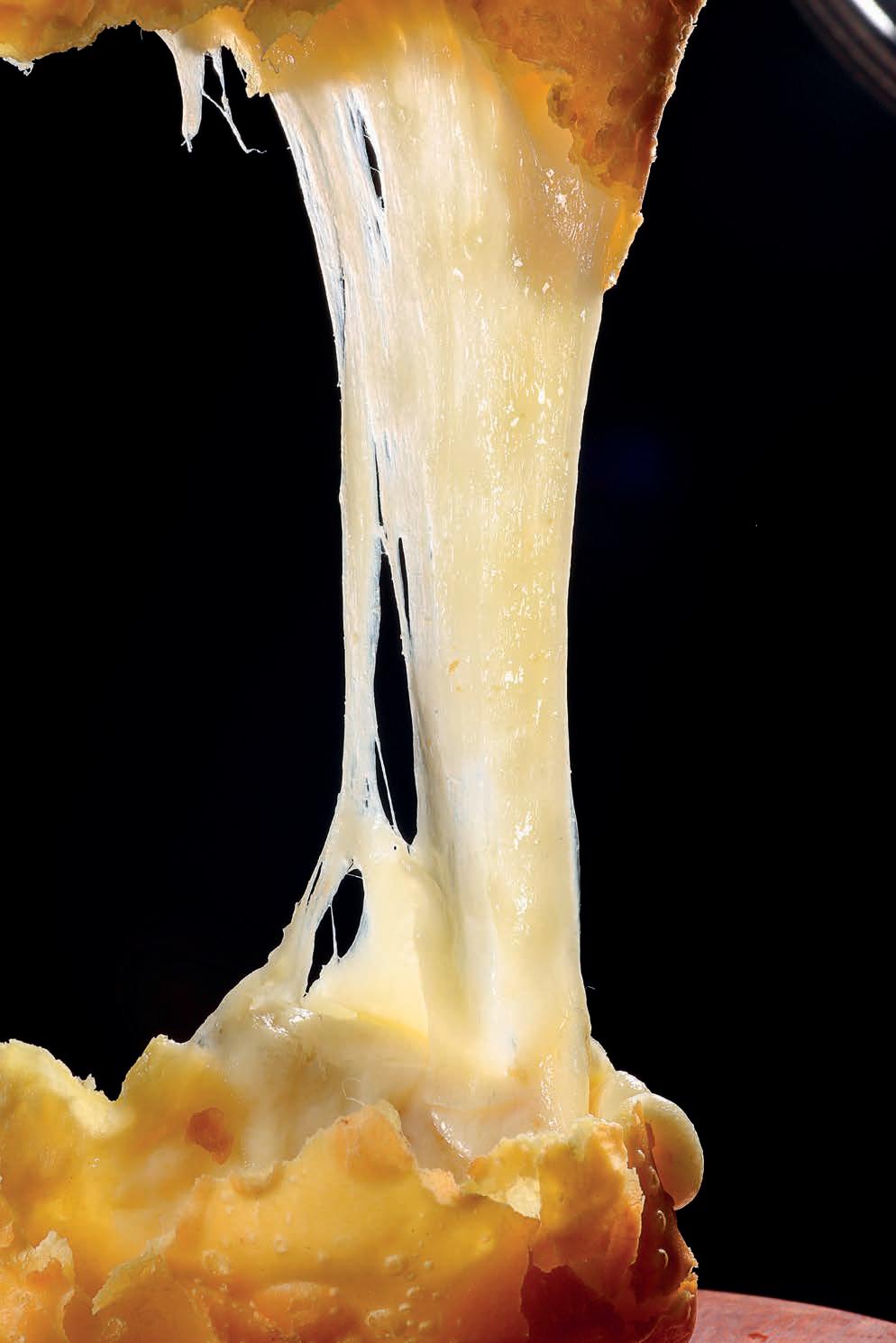
Dimetix has been developing and manufacturing laser distance sensors for more than 20 years. As a company that is proud of being Swiss, we aim for the highest possible quality, resulting in unique, accurate longdistance sensors - the solution that provides applications for the most accurate demands for measurement.
With Dimetix, even the most challenging applications can be realised due to its technical application support available to all of its customers.
•The products measure distances of up to 500 metres, with an accuracy of ±1 millimetre.
•Each sensor includes the majority of features, so selecting the sensor that is right is easy.
•Sensors are always available in stock, which guarantees the shortest delivery times.
The D-Series Dimetix Laser Distance Sensors is at the forefront of our continuous development and innovation. They measure long distances with the highest precision, reliability and speed, even in the most difficult situations. The D-series can measure on dark surfaces - even in exterior applications with solar irradiation. With this series, which is now available in a new modern design. Dimetix has expanded its product range with a device, that has an output rate of 1 kHz.
The Dimetix laser distance measuring devices are being used in a variety of industries, such as metal, wood, hydro tech, railways, paper, mining, glass, process, transport and automotive and cranes

AMS Instrumentation Ph: 03-9027 8225 sales@ams-ic.com.au www.ams-ic.com.au
Backplane Systems Technology has announced the APLEX AUHMI816BP(H), a 15.6-inch industrial panel PC that is designed for factory automation and industrial environments. Powered by Intel Celeron processors, this compact panel PC is equipped with a 1 x 260pin SO-DIMM DDR4 slot, supporting up to 32GB of 3200MHz memory for optimal multitasking performance. The flat front panel touch-screen includes an IP66-rated bezel, ensuring durability against dust and water, ideal for rugged applications. Its fanless design and DC 9-36V wide-ranging power input enhances reliability and energy efficiency. Additionally, the AUHMI-816BP(H) supports expansion through M.2 E-key and B-key slots, allowing easy customisation for specific application needs. The TPM 2.0 hardware security offers advanced data protection, a key feature for secure industrial operations.
Optional high brightness of 1,000
nits improves visibility, especially in high-light conditions, while easy assembly mounting kits streamline installation. With its robust construction, the AUHMI-816BP(H) is suitable for a variety of industrial applications, including smart manufacturing, process control, and real-time monitoring. This costeffective, high-performance solution combines rugged design with modern functionality, boosting productivity and reliability in demanding environments.
Key features:
•15.6-incg industrial compact size panel PC.
•Intel Celeron processors.
•1 x 260-pin SO-DIMM DDR4 slot, up to 32GB 3200MHz.
•Flat front panel touch screen with IP66 front bezel.
• Fanless design.
• DC 9~36V wide-ranging power input.
•Support expansion via M.2 E-key and B-key slots.

•Support TPM 2.0 hardware security.
•Easy assembly mounting kits.
•High brightness 1,000 nits for option.
Backplane Systems Unit 14/12 Yatala Rd, Mount Kuring-Gai NSW 2080 (02) 9457 6400
www.backplane.com.au
Interface is a source of quality precision force sensor technologies used throughout the product lifecycle from concept and R&D, through engineering and testing, to manufacturing and eventually consumption. Interface supply force measurement solutions for use in equipment, machines, tools, and integration into actual products to measure performance and use. It provides products to accurately measure and monitor hardware used in CPG distribution. Interface load cells and instrumentation help CPG product designers and fabricators drive usability, adoption, production efficiencies, and ensure safety to satisfy the needs of all consumers. Consumer products are made across all types of industries, from healthcare to automotive. Interface force measurement solutions are used to predict failure and identify design challenges before these goods enter the public domain. It is hard to imagine any consumer product not going through rigorous test
and measurement protocols before someone finds it in the marketplace. From testing furniture to ensuring your household appliances are safe and durable, Interface’s sensor measurement technologies have a critical role in a variety of types of testing in the creation and manufacturing of everyday goods.
Manufacturing CPGs
Interface force measurement solutions are commonplace in R&D labs, design houses, manufacturing environments and even packaging plants for consumer goods. For industrial robotic arms, measurement of force and torque when an arm lifts items, and places them down again is one example of how sensors improve performance in the manufacturing process of final goods. An industrial automation engineer wanted to ensure the robotic arm would operate efficiently and actually improve the packaging process. Interface created a custom solution using our 6A40 6-Axis Load Cell, which was installed
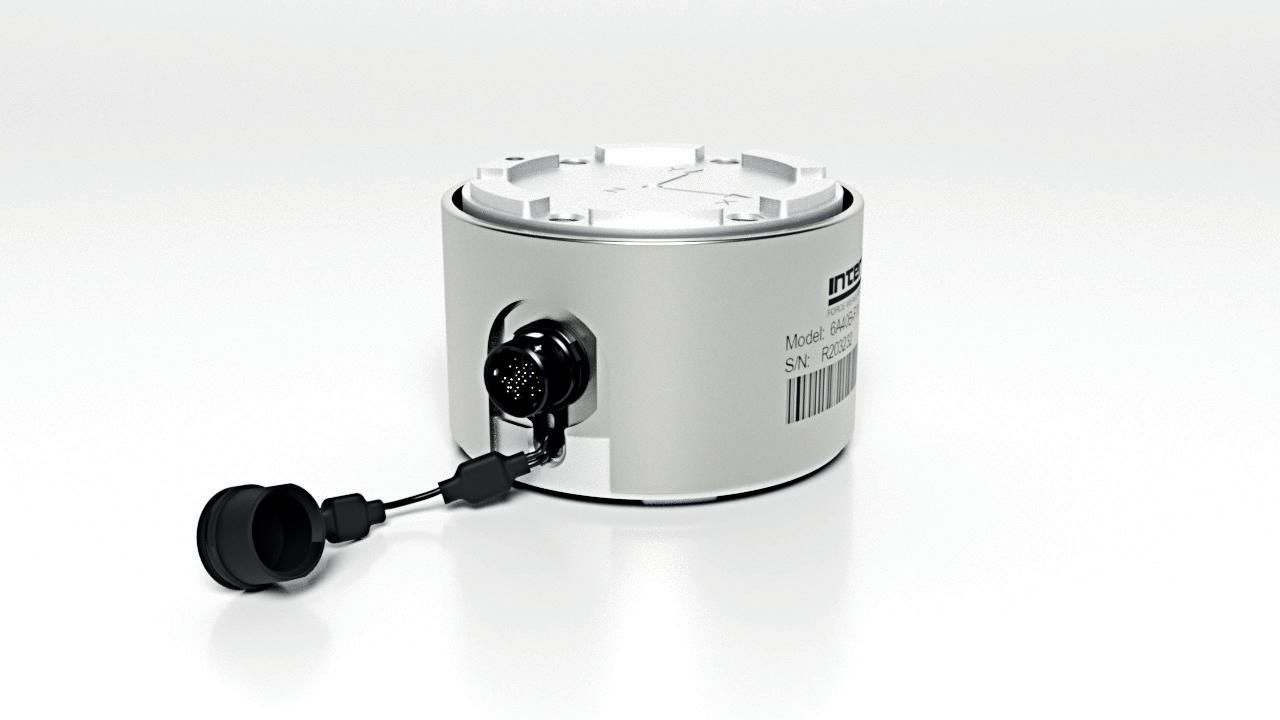
at the wrist of the robotic arm. The 6A40 was able to measure all forces and torques (FX , FY, FZ , M X , M Y, M Z).
This load cell was connected to its BX8 8-channel data acquisition system and amplifier with BlueDAQ software, where results were displayed, logged, and graphed for monitoring.
AMS Instrumentation
Ph: 03-9027 8225
sales@ams-ic.com.au www.ams-ic.com.au
The Huber Instrumente modular built pressure-calibrator TM40 is unique in its conception. The device is built modular with four slide-in slots that are freely configurable.
This allows the TM40 pressure calibrator to be equipped completely individually to suit the end users need. There are three different types of modules, to select from:
•Measuring module (MM40).
•Generator module (GM40).
The measurement module needs 1 slot in the TM40.
It’s possible to cover four different measurement ranges with the TM40.
•Accuracy classes up to 0.05% F.S. selectable.
•Symmetrical measuring ranges available.
•-1 up to 250 bar.
The Generator Module needs 2 slots in the TM40.
It’s also possible to operate two GM40’s in the device, or one GM40 and two MM40‘s.
• Measure pressure.

•Generate pressure and automatically regulate it.
•Control accuracy of pressure generation is 0.1 Pa.
•Accuracy classes up to 0.05% F.S. selectable.
•Symmetrical measuring ranges available.
•Automatic pressure regulation up to -/+ 10000 Pa.
•Built in step generator. The GM40 is able to build up and regulate the pressure of a given setpoint autonomous.
•Maximum of 20 measurements per second.
•Graphical display of the pressure measurements in real time.
• Touchscreen.
•USB com-port.
•SD card.
• Temperature compensated sensors.
•Long term stability.
•Li-Ion rechargeable battery.
AMS Instrumentation Ph: 03-9027 8225
sales@ams-ic.com.au www.ams-ic.com.au



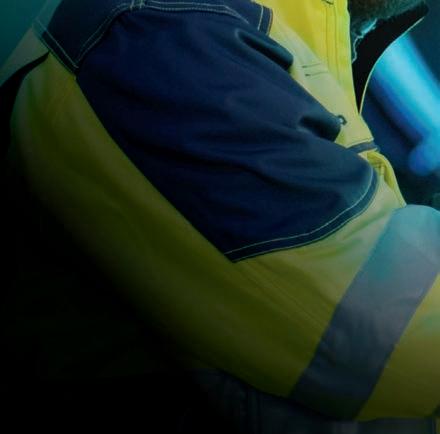







Leave it to us!






















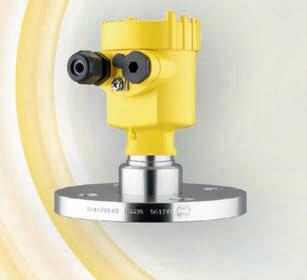

Our technologies o er everything you need for process, hydrostatic, and di erential pressure for process automation. Around the world, VEGA pressure solutions stand for proven reliability and trend-setting innovation. Our pressure measurement solutions go beyond just e cient, optimised processes – they provide you with peace of mind, knowing that you’ve chosen the best technology available. Everything is possible. With VEGA.






